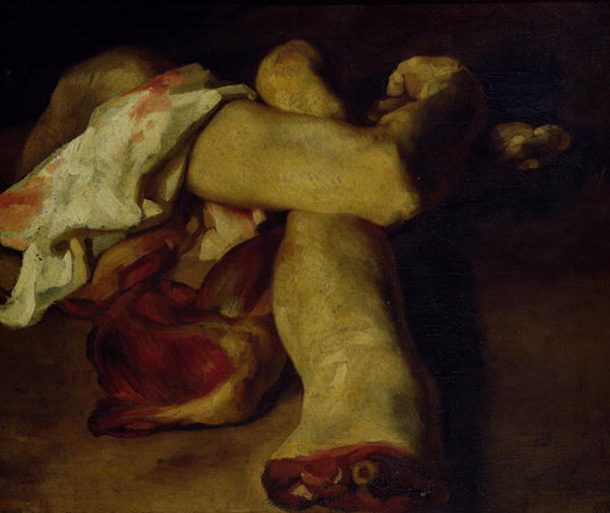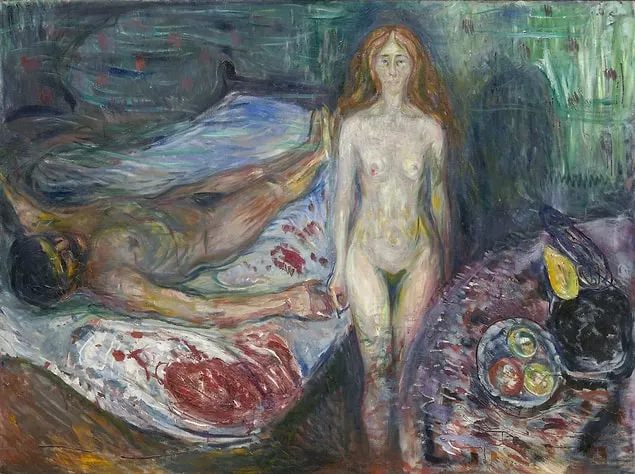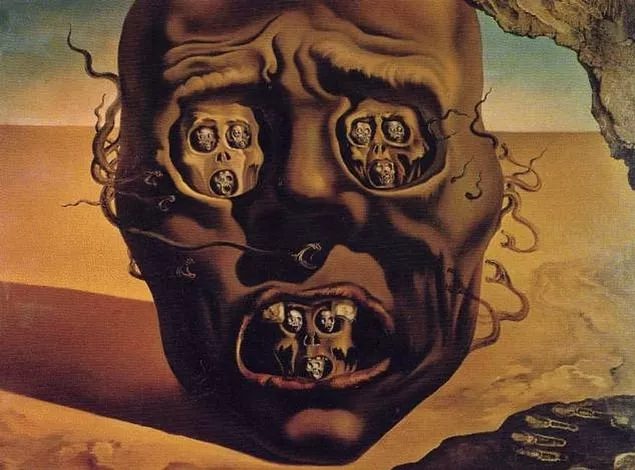Art can evoke many emotions, from joy and awe to sorrow and fear. For centuries, artists have been pushing the boundaries of their craft, exploring the depths of the human psyche and creating works that challenge, provoke, and sometimes even disturbing. If you’re intrigued by the darker side of art, you’re in for a treat: we’ve compiled a list of some of the most disturbing paintings that will leave a lasting impression on your mind.
Our list of disturbing paintings spans different periods, styles, and cultures, showcasing the diverse ways artists have delved into the unsettling and the uncanny. These works often tackle difficult themes such as war, suffering, and the darker aspects of human nature. Through their haunting imagery and evocative use of color and form, these paintings invite viewers to confront their fears and anxieties and reflect on the complexities of the human condition.
While some may find these paintings uncomfortable or even distressing, it’s important to remember that art often serves as a means of exploring and grappling with the darker aspects of life. By confronting the unsettling and the macabre, these works can provide a cathartic experience for the viewer, allowing them to process their own emotions and experiences safely and constructively. Furthermore, these disturbing paintings often challenge societal norms and expectations, encouraging viewers to question the status quo and consider alternative perspectives.
As you explore our list of disturbing paintings, you’ll likely find yourself experiencing a wide range of emotions, from fascination and curiosity to unease and apprehension. This is a testament to the power of art to engage and provoke, pushing us beyond our comfort zones and inviting us to reflect on our own lives and the world around us. These paintings may not be easy to look at, but they offer a unique opportunity for introspection and personal growth.
So, if you’re ready to embark on a journey through the darker side of art, we invite you to dive into our compilation of disturbing paintings. Keep an open mind, and you may discover that these unsettling works hold a certain allure, offering valuable insights into the human experience and the shadowy corners of our collective psyche. And don’t forget to share your thoughts and impressions with others, as engaging in dialogue about these challenging works can lead to a deeper understanding and appreciation of their significance.
#1 The Smiling Spider by Odilon Redo, 1887
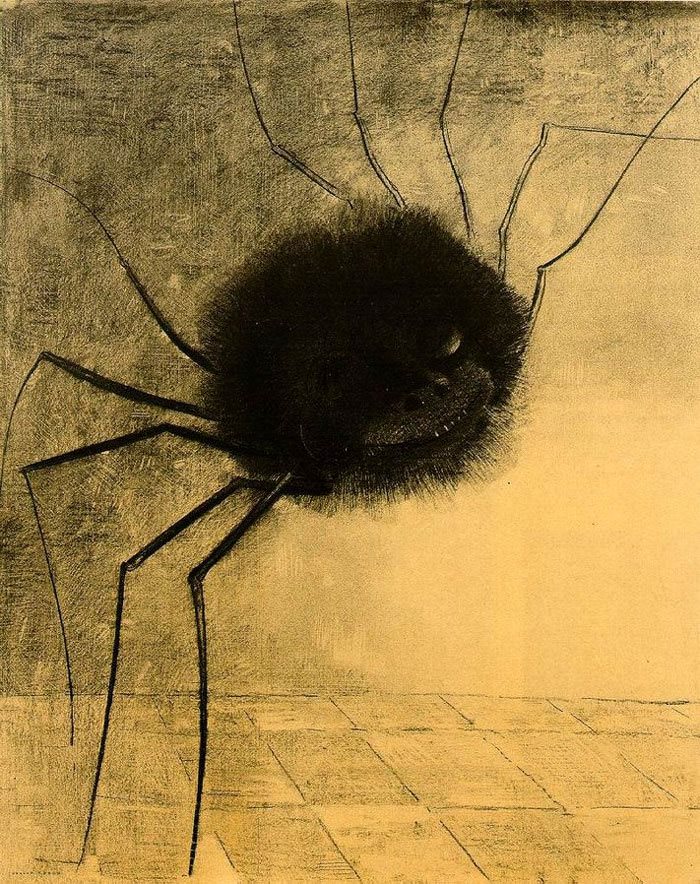
The Smiling Spider is a painting created by French artist Odilon Redon in 1887, during the Symbolism movement. The painting is known for its surreal and unsettling depiction of a spider with a human-like face, grinning with a wide and eerie smile.
Redon was fascinated with the macabre and supernatural, which is reflected in many of his works. The Smiling Spider is no exception, as it plays on the fear and revulsion many people feel towards spiders and other arachnids. The addition of the human-like face, with its twisted grin, adds an extra layer of terror to the piece.
Despite its unsettling nature, The Smiling Spider is also an example of Redon's mastery of color and form. The spider itself is rendered in a vibrant red and black, with intricate details in its legs and body. The background is a muted green, creating a sense of unease and otherworldliness. The Smiling Spider has become a famous and iconic image in the horror and surrealism genres. Its unsettling nature and masterful execution continue to captivate and disturb viewers to this day.
#2 Untitled by Zdzislaw Beksinski, 1984

Zdzislaw Beksinski was a renowned Polish painter known for his surreal and dystopian works. Completed in 1984, "Untitled" is one of his most famous paintings. The piece depicts a haunting landscape that appears to be a post-apocalyptic wasteland. The color palette is muted and desaturated, creating a sense of bleakness and despair.
What makes this painting particularly eerie is the use of distorted human figures and strange, otherworldly creatures. The figures appear to be in a state of agony, writhing and contorting in pain. The creatures resemble distorted, demonic beings with elongated limbs and twisted features. The overall effect is a disturbing and unsettling portrayal of a world gone horribly wrong.
Beksinski's style is often described as surrealism, but it is unique in its own right, drawing from a variety of influences, including Gothic art and horror cinema. His works often explore themes of death, decay, and the horrors of war. "Untitled" is a prime example of his ability to create a terrifying and otherworldly atmosphere, leaving the viewer with a sense of unease and dread.
#3 The Abbey in the Oakwood by Caspar David Friedric, 1810

"The Abbey In The Oakwood" is a haunting oil painting created in 1810 by German Romantic artist Caspar David Friedrich. The painting depicts a Gothic abbey in ruins, surrounded by a desolate forest of bare oak trees. The scene is set at dusk, with a full moon rising in the background, casting an eerie light over the barren landscape.
The painting is a representation of the transience of life, as the abbey symbolizes the inevitability of death and the cyclical nature of life. The oak trees are a symbol of strength, endurance, and fertility, but in the painting, they are stripped bare, representing death and decay. The painting also reflects Friedrich's fascination with the sublime and the emotional power of nature, as he portrays the natural world as both beautiful and terrifying.
The painting has a somber and melancholic mood, which is typical of Friedrich's works. The use of muted colors, the play of light and shadow, and the strong vertical and diagonal lines all contribute to the haunting atmosphere of the painting. "The Abbey In The Oakwood" is a masterpiece of Romanticism, and its haunting imagery has continued to captivate viewers for over two centuries.
#4 Medusa by Michelangelo Merisi da Caravaggi, 1597

Michelangelo Merisi da Caravaggio’s painting of Medusa, completed in 1597 during the Baroque period, is an intriguing and terrifying depiction of the exact moment Perseus slays the Gorgon. Caravaggio deviates from traditional portrayals of Medusa by swapping her face with Perseus’s, implying his resistance to her lethal gaze. The painting showcases Caravaggio’s fascination with brutality and realism, demonstrated by his intricate and unique style.
It is believed that Cardinal del Monte commissioned Caravaggio to create two versions of Medusa to rival Leonardo da Vinci’s earlier depiction of the mythological creature. Unfortunately, da Vinci’s painting is now lost, so it is impossible to know how closely Caravaggio’s rendition matched up with the master’s.
Despite this, Caravaggio’s Medusa remains a masterpiece of the Baroque period, both in terms of its composition and technique. The intricate details and dramatic use of light and shadow make it a truly terrifying work of art. The painting's realism and brutality, coupled with its unique approach to Medusa's face, have secured its place as one of Caravaggio's most intriguing and memorable works.
#5 Takiyasha the Witch and the Skeleton Specter, Utagawa Kuniyoshi, 1844
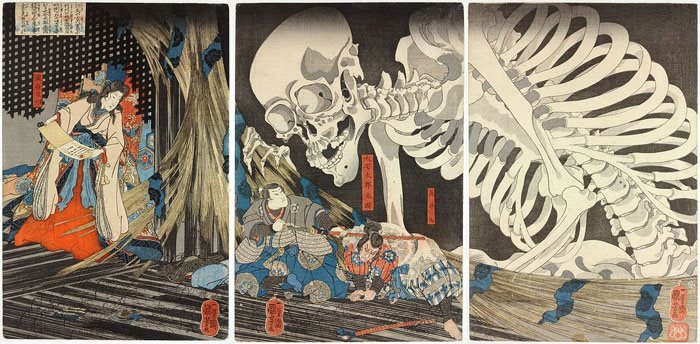
Takiyasha the Witch and the Skeleton Specter is a woodblock print created by Japanese artist Utagawa Kuniyoshi in 1844. The artwork depicts a scene from a Japanese legend in which Takiyasha, a powerful sorceress, summons a group of skeleton specters to rise from the dead and protect her from her enemies.
In the print, Takiyasha stands confidently in the foreground, holding a lantern and gazing out at the viewer. Behind her, a group of fierce-looking skeleton warriors emerge from the darkness, wielding swords and shields. The eerie, otherworldly atmosphere of the print is heightened by the use of dark, muted colors and the dramatic play of light and shadow.
The artwork is notable for its intricate details and complex composition, which combine to create a powerful and unsettling effect. It is regarded as one of Kuniyoshi's finest works, showcasing his mastery of the woodblock printing technique and his ability to capture the essence of Japanese folklore and mythology.
#6 Study After Velázquez’s Portrait Of Pope Innocent X, 1953
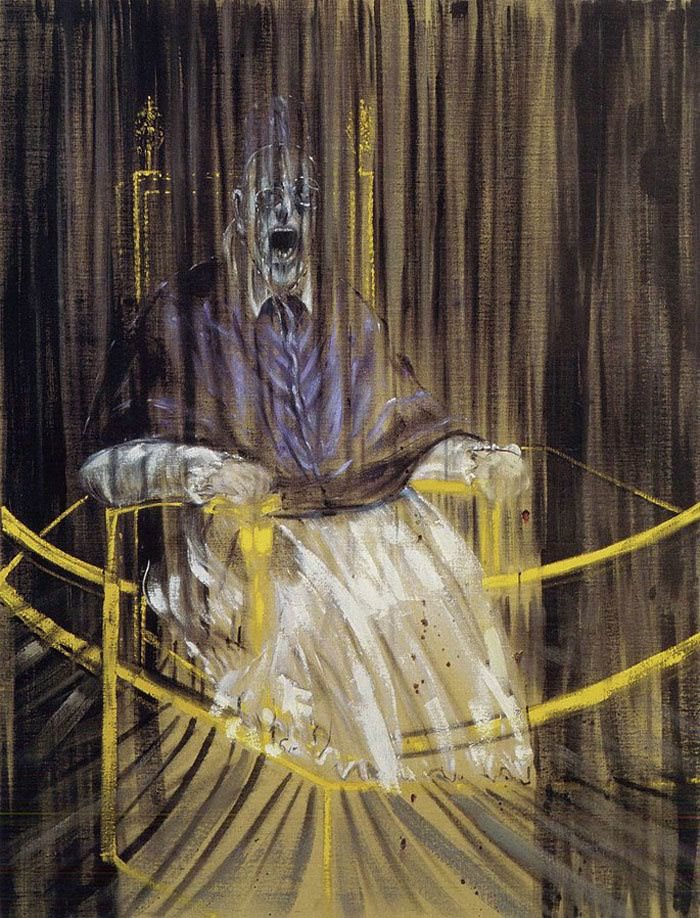
Francis Bacon's "Study after Velázquez's Portrait of Pope Innocent X," completed in 1953, is a disturbing and haunting work of art. The painting is part of a series of variations on the portrait by Diego Velázquez, which depicts Pope Innocent X with an intense and penetrating gaze.
In Bacon's rendition, the Pope's face is distorted and contorted, creating a sense of anxiety and fear. The red tones of the Pope's garments and the background heighten the sense of unease and dread, giving the painting a dark and ominous mood.
Bacon's use of Expressionism in this piece is evident in his focus on the emotional and psychological aspects of the painting, rather than the physical. His emphasis on the Pope's facial expression and the use of bold, expressive brushstrokes to create a sense of movement and energy add to the emotional intensity of the work.
The painting has been interpreted as a comment on the power and corruption of the Catholic Church, as well as a reflection of Bacon's own personal struggles with anxiety and fear. Regardless of its meaning, "Study after Velázquez's Portrait of Pope Innocent X" is a powerful and unsettling work of art that continues to captivate and disturb viewers to this day.
#7 The Garden of Earthly Delights, Hieronymus Bosch, 1505
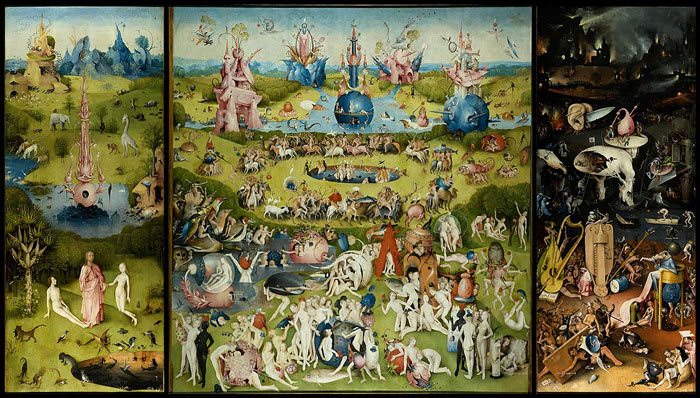
The Garden of Earthly Delights is a triptych painting created by the Dutch artist Hieronymus Bosch in 1505. The painting is believed to be a representation of the Garden of Eden and the story of human sin and damnation. The left panel portrays the creation of Adam and Eve, the center panel depicts a surreal landscape full of bizarre creatures, and the right panel depicts Hell.
The painting is notable for its imaginative and disturbing imagery, which includes surreal landscapes, bizarre creatures, and graphic depictions of torture and damnation. The Garden of Earthly Delights has been interpreted in various ways, with some scholars suggesting that it is a warning against the dangers of sin and others arguing that it is a celebration of pleasure and indulgence.
Despite its controversial subject matter, The Garden of Earthly Delights has become one of the most famous and influential works of art in history. The painting has been celebrated for its innovation and creativity, and it continues to inspire artists and art enthusiasts to this day.
#8 Young Holding his Dead Daughter, 1804
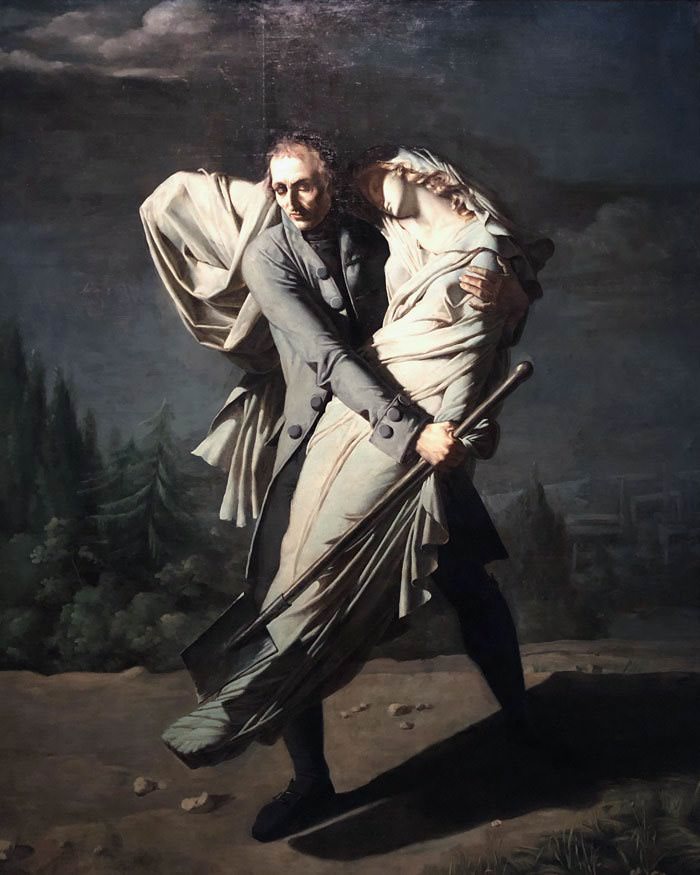
Pierre-Auguste Vafflard displayed this stunning picture of love and death at the Salon in 1804. Here, fatherly love is what prompts poet Edward Young to struggle yet continue to carry his deceased daughter's body in the cold moonlight. It's a heart-wrenching story that inspired Pierre-Auguste Vafflard to create this emotional masterpiece. The painting captures the raw emotion of a father who is unable to let go of his beloved daughter, even in death. Young's posture, holding his daughter's body in his arms, is a powerful representation of his grief and love for her. The painting's use of light and shadow adds to the emotional impact, as the moonlight illuminates the scene, casting a pale, ghostly light on the figures.
Vafflard's painting is a perfect example of the Romanticism movement, which emphasized intense emotion, individualism, and the sublime. The painting captures the tragic and emotional nature of the human experience, reminding viewers of the fragility of life and the power of love. Through this painting, Vafflard immortalized Young's grief and the love he had for his daughter, creating a work that will continue to move and inspire viewers for centuries to come.
#9 Premonition, 1893
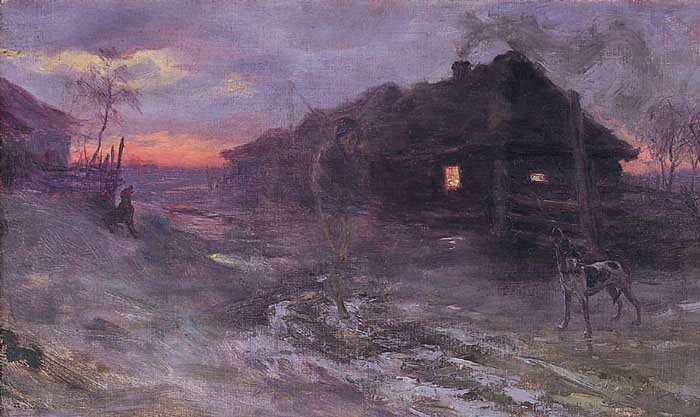
Interestingly, there's not much information available about Henryk Weyssenhoff or his artwork, and little analysis has been made to examine his works. Premonition, or originally Przeczucie, one of his most recognized works, is believed to have been created around 1893. The artwork seems to portray a ghostly-looking Grim Reaper standing in the center of the picture in what appears to be a quiet village or a farmstead. In the painting, there are also two dogs who appear to be howling at the presence of Death.
#10 Skull of a Skeleton with Burning Cigarette, 1886
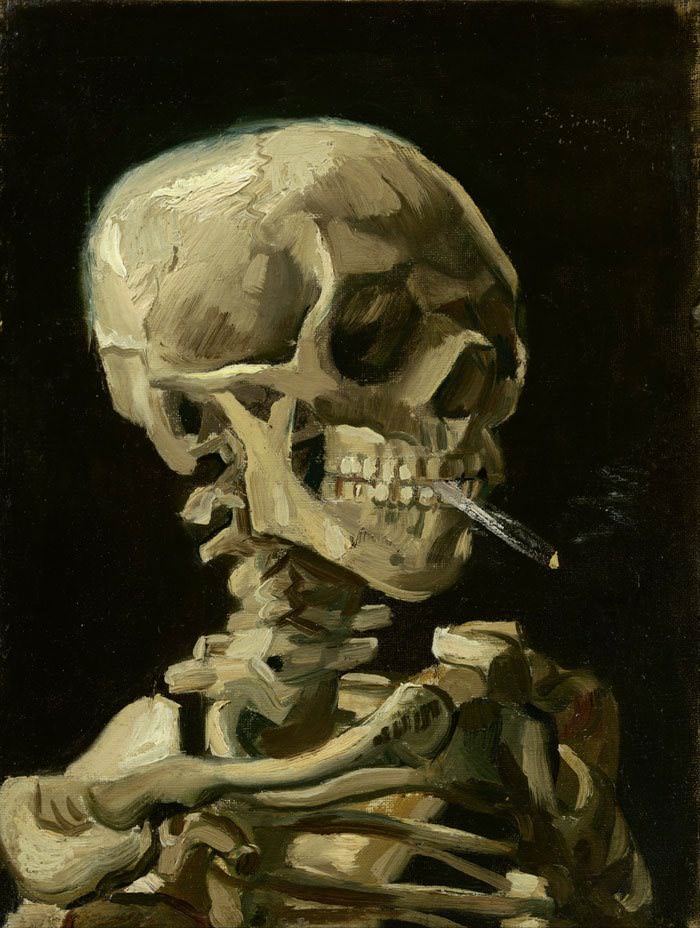
Skull of a Skeleton with Burning Cigarette is an oil painting created by Vincent van Gogh in 1886. The painting is often considered to be a self-portrait of van Gogh, who was known for his love of smoking cigarettes. The painting features a skeleton with a lit cigarette in its mouth, which is a symbol of death and mortality. The painting is believed to be a reflection of van Gogh's own struggle with mental illness and his contemplation of death.
Van Gogh's style in Skull of a Skeleton with Burning Cigarette is considered to be post-impressionist, a style that he helped pioneer. The use of bright, bold colors and the thick, textured brushstrokes are typical of his style. The painting is also considered to be a representation of the realist movement, which sought to depict the world as it truly is. The painting was part of a series of works that van Gogh created during his time in Paris, where he was exposed to a range of different styles and techniques. Today, Skull of a Skeleton with Burning Cigarette is considered to be one of van Gogh's most iconic works and is on display at the Van Gogh Museum in Amsterdam.
#11 Girl with Death Mask by Frida Kahlo, 1938

Girl with Death Mask is a painting completed by the iconic Mexican artist Frida Kahlo in 1938. The painting depicts a young girl wearing a death mask, which was a common tradition in Mexican culture during the Day of the Dead festival. The girl is shown sitting in a chair with her hands folded, staring directly at the viewer with a solemn expression. Behind her, a black background adds to the haunting and somber atmosphere of the piece.
Kahlo was known for exploring themes of death and mortality in her artwork, and Girl with Death Mask is a prime example of this. However, the painting also reflects Kahlo's personal struggles with chronic pain and illness, as well as her fascination with Mexican cultural traditions. The use of bold, vivid colors and the flattened perspective are also typical of Kahlo's style, which drew from elements of abstraction and postmodernism.
Today, Girl with Death Mask is considered a masterpiece of Mexican art and a powerful example of Kahlo's unique vision and artistic talent. It continues to captivate viewers with its haunting imagery and emotional resonance.
#12 The Phantom of Kohada Koheiji by Katsushika Hokusai, 1831
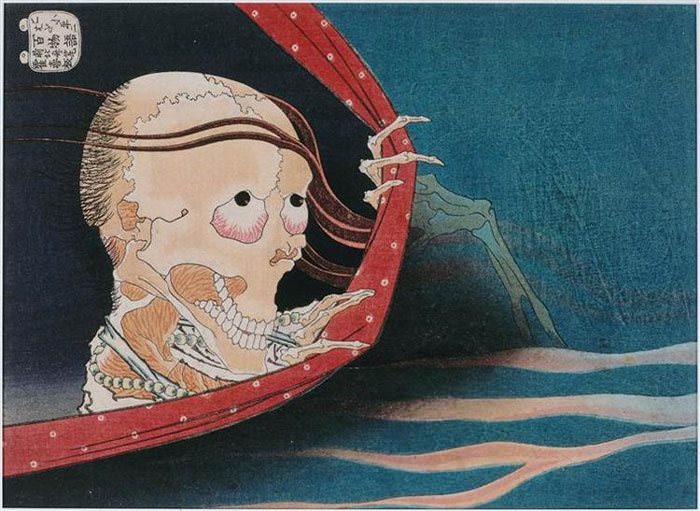
Katsushika Hokusai was a famous Japanese artist who is best known for his ukiyo-e prints, and "The Phantom of Kohada Koheiji" is one of his famous works completed in 1831. The artwork depicts a ghostly apparition of a murdered samurai named Kohada Koheiji, who appears to be rising from his coffin with his head tilted upwards. The ghost is depicted in a traditional samurai attire and is holding a lantern, which illuminates his face and surroundings. The artwork is part of a larger series called "One Hundred Ghost Tales," which consists of a hundred ghost stories that were popular in Edo-era Japan. The Phantom of Kohada Koheiji is one of the most iconic images from the series, and it continues to be a popular subject in Japanese horror films, literature, and theater. Hokusai's use of striking colors, bold lines, and attention to detail make this artwork a masterpiece of Japanese horror and a prime example of ukiyo-e art.
#13 The Nightmare by Henry Fuseli, 1781
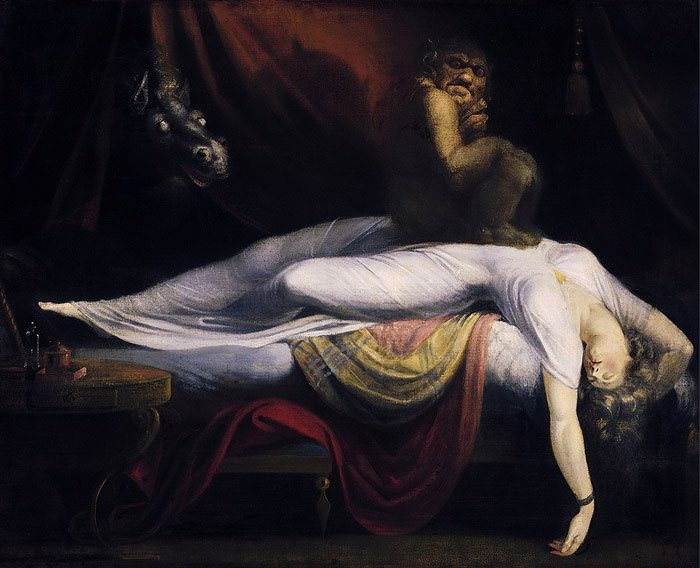
"The Nightmare" is a masterpiece of Romanticism by Swiss-born artist Henry Fuseli. Completed in 1781, this oil painting portrays a young woman lying on her bed with a demonic figure, which is believed to be an incubus or demon, perched on her chest. The woman appears to be in a deep sleep, perhaps even experiencing a nightmare, as the incubus gazes down at her with a sinister expression. The painting is highly symbolic, with various interpretations suggesting that it represents sexuality, the supernatural, and the subconscious mind.
Fuseli was heavily influenced by the Gothic literature of the time, and "The Nightmare" is considered to be one of the most iconic examples of Gothic art. The painting's dark and moody atmosphere, coupled with its highly detailed and realistic depiction of the supernatural, has captured the imagination of art lovers for centuries. In fact, "The Nightmare" is one of the most frequently reproduced works of art in history and has been the subject of numerous films, novels, and other works of art.
#14 Knight, Death and the Devil by Albrecht Dürer, 1513
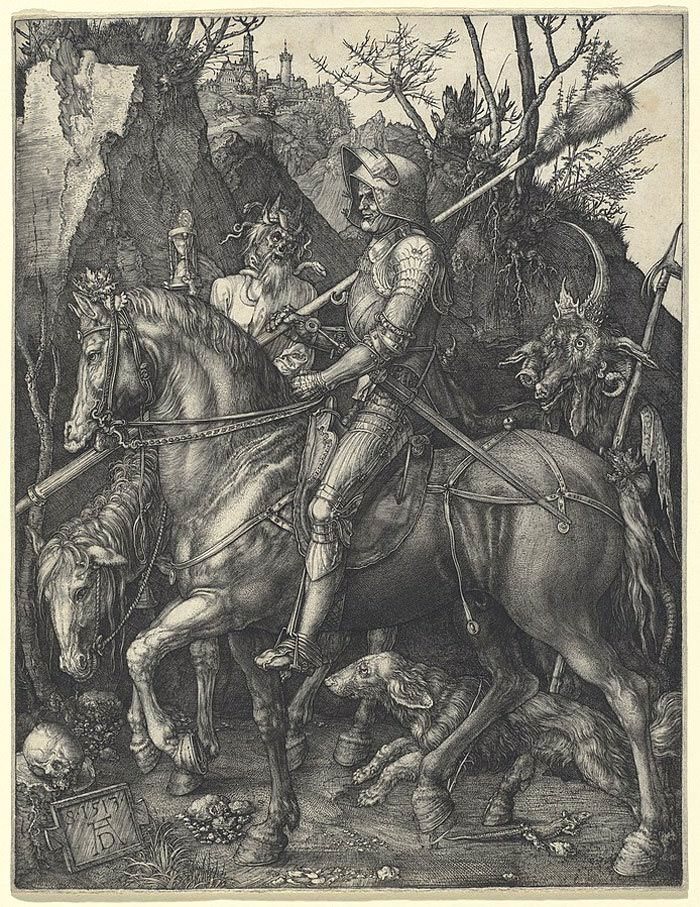
Knight, Death and the Devil is an engraving by the German artist Albrecht Dürer, completed in 1513 during the Northern Renaissance period. The engraving depicts a mounted knight riding through a narrow gorge, accompanied by a goat and his faithful dog. The knight is armed and appears to be impervious to the menacing figures that surround him, including Death, who holds an hourglass, and the Devil, who is shown in the guise of a menacing, half-human creature.
The work has been the subject of much interpretation and analysis, with some scholars suggesting that it represents a Christian allegory of the virtues of fortitude and faith. Others have seen it as a more secular work, celebrating the humanist ideals of the Renaissance. Whatever its interpretation, Knight, Death and the Devil is widely regarded as one of Dürer's most impressive works, showcasing his mastery of the art of engraving and his skill at creating powerful and evocative images that continue to fascinate and inspire viewers today.
#15 Lucifero by Francesco Scaramuzza, 19th Century
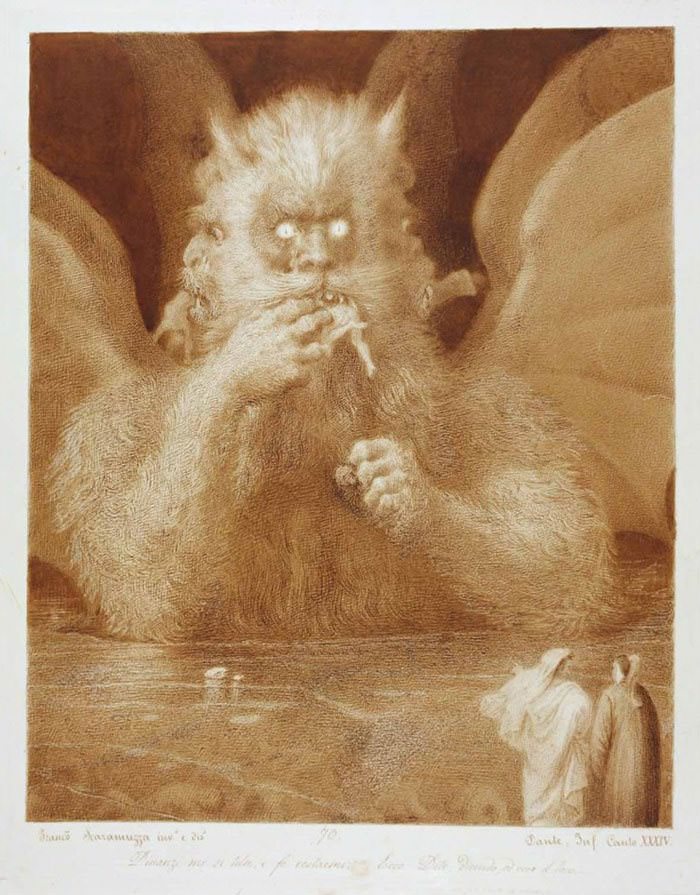
There's little information known about the painting or the artist who painted Lucifero. Francesco Scaramuzza was an Italian painter and poet who lived during the Northern Italian Romantic era. He mainly created mythological and historical works of art. Still, he is best renowned for his interpretations of literary figures such as Dante, a project to which he devoted decades of his life. The artwork above depicts Lucifer from Dante's Inferno.
#16 The Picture of Dorian Gray by Ivan Albright, 1943
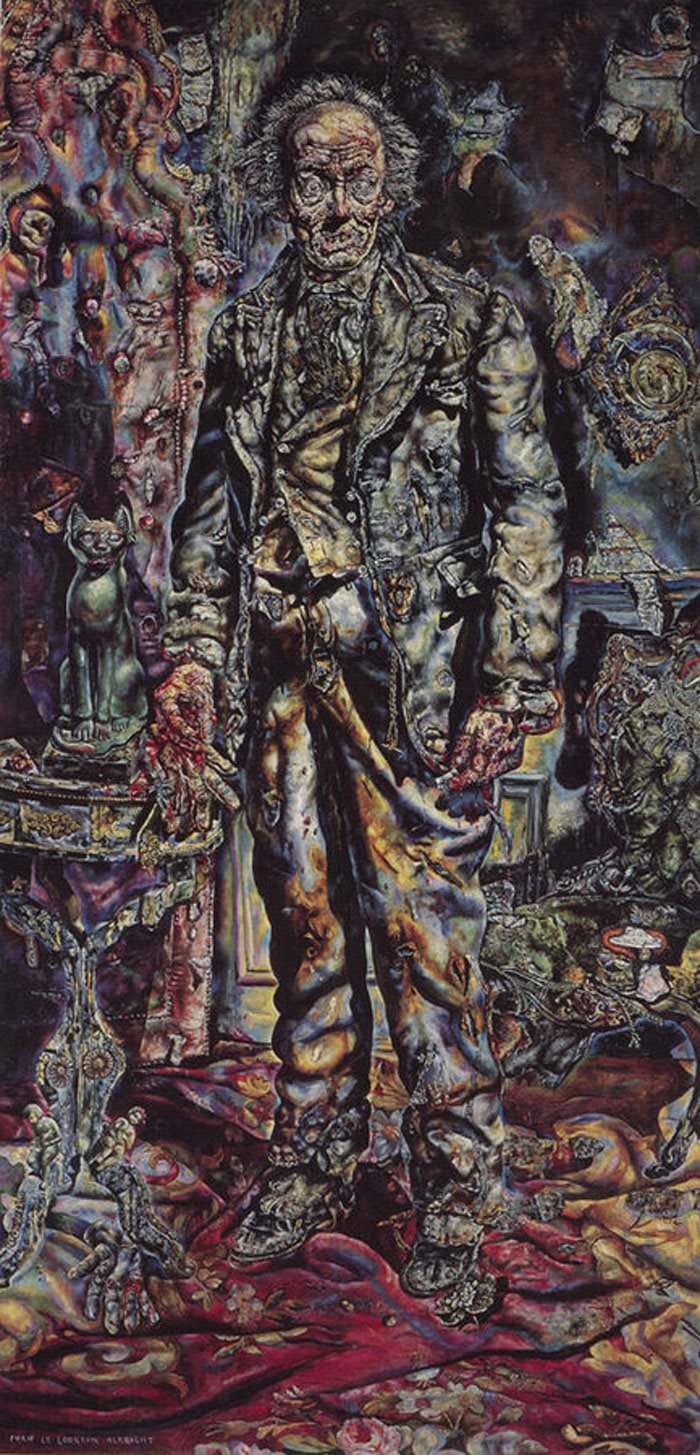
Ivan Albright's The Picture of Dorian Gray is a striking example of Magic Realism, painted in 1943. The artwork is based on Oscar Wilde's famous novel of the same name, which follows the life of Dorian Gray, a young man who makes a pact with the devil to remain forever young and beautiful while his portrait ages and decays in his place.
The painting depicts Dorian Gray's portrait as a grotesque and unsettling figure, with distorted features, leathery skin, and rotting flesh. The detailed and realistic style of the painting draws the viewer's attention to the decay and corruption that lie beneath the surface of beauty and youth, which is the central theme of the novel.
Albright spent over a year working on the painting, using a layering technique that involved applying multiple layers of paint and glazes to achieve a sense of depth and texture. The result is a haunting and unsettling masterpiece that captures the essence of Wilde's novel and the darker side of human nature.
#17 Skeletons Fighting over a Pickled Herring by James Ensor’s Skeletons, 1891
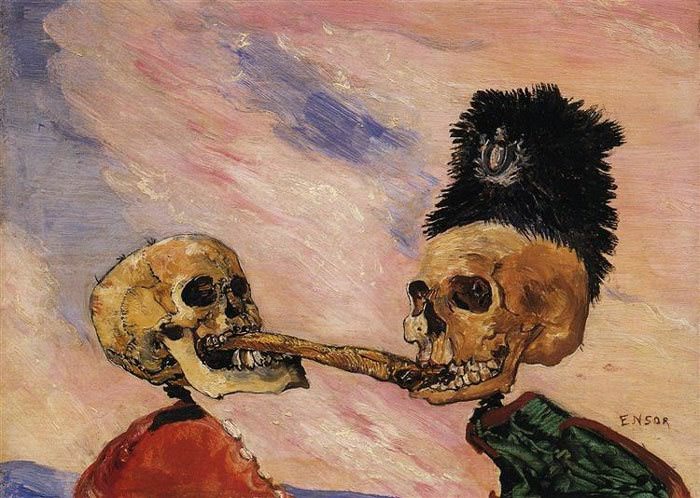
James Ensor's Skeletons Fighting Over A Pickled Herring is an iconic painting from the Belgian artist, completed in 1891. The painting depicts a chaotic and macabre scene of skeletons fighting over a single pickled herring, with their bones tangled and intertwined in a grotesque display. The painting has been interpreted in many ways, with some seeing it as a commentary on the futility of material possessions and the absurdity of human greed, while others view it as a satire on the art world and the competition for recognition and fame. The painting is notable for its use of bright, vivid colors and bold brushstrokes, which create a sense of movement and energy despite the stillness of the skeletal figures. Ensor's unique style and iconography have made him one of the most influential artists of the early 20th century, and Skeletons Fighting Over A Pickled Herring is considered one of his most important works.
#18 Witches’ Sabbath by Francisco De Goya’, 1798
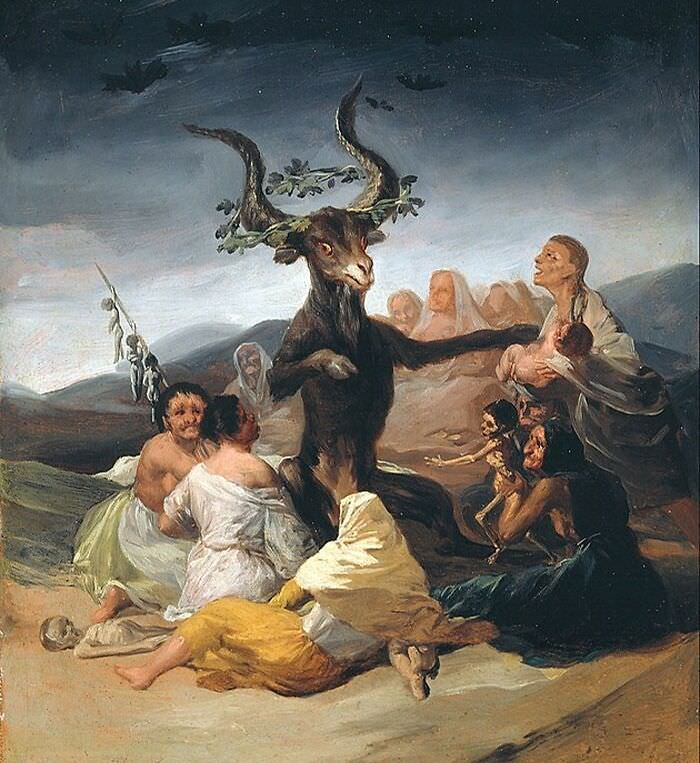
Francisco De Goya's Witches' Sabbath is a frightening and fascinating piece of art that embodies the artist's fascination with the supernatural and the dark side of humanity. The painting depicts a group of witches and demons gathered in a chaotic and demonic setting. The center of the painting is occupied by a large goat-like figure, believed to represent Satan or Baphomet, who presides over the ceremony. The witches are shown engaging in various rituals and acts of sorcery, such as drinking from cauldrons and dancing around the fire. The entire scene is dark and ominous, with a menacing aura that captures the viewer's attention.
Goya's Witches' Sabbath is considered one of the most influential and captivating depictions of witchcraft in art history. It reflects the Romantic era's fascination with the supernatural and the occult, as well as the artist's own experiences and beliefs. The painting is a powerful statement on the dangers of superstition and the human obsession with the unknown and the forbidden.
#19 Portrait of Antonietta Gonzalez by Lavinia Fontana, 1595
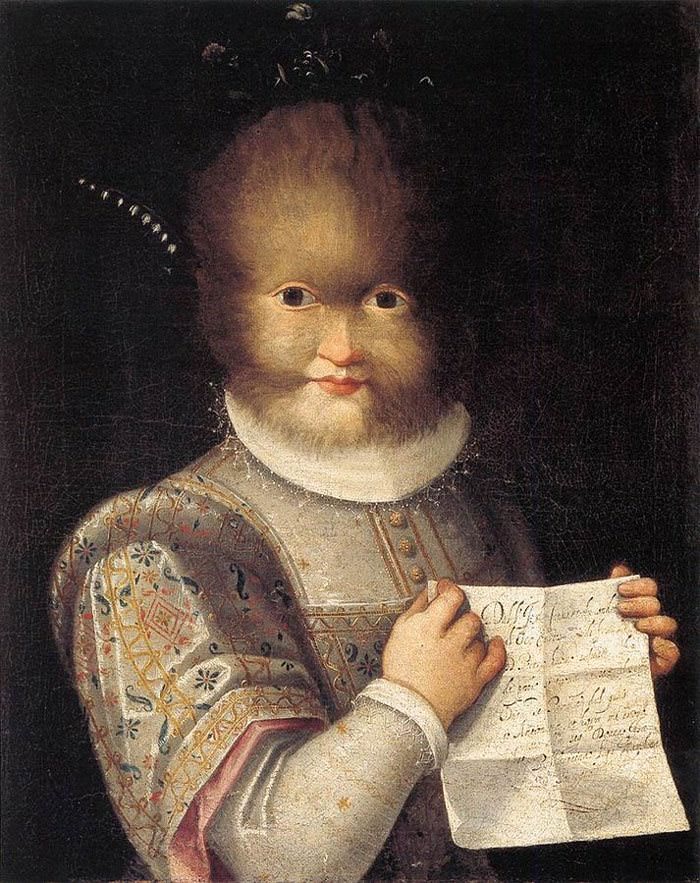
Lavinia Fontana was a highly skilled and talented artist of the Late Renaissance period, known for her portrait paintings. One of her most famous works is the Portrait of Antonietta Gonzalez, completed in 1595. This stunning portrait depicts a young woman dressed in lavish clothing and adorned with jewelry, standing against a black background. The sitter's face is painted with incredible detail, showcasing Fontana's exceptional skills in capturing the likeness and expression of her subjects. The use of light and shadow adds depth and dimension to the painting, creating a sense of realism and vitality.
The portrait of Antonietta Gonzalez is a prime example of the Mannerist style of painting that emerged during the Late Renaissance period. This style is characterized by its exaggerated and stylized approach to portraiture, with elongated figures, distorted poses, and elaborate ornamentation. Fontana's painting captures the essence of Mannerism, with its intricate details and intricate patterns, while also demonstrating her exceptional talent as a portrait painter. The portrait of Antonietta Gonzalez remains a masterpiece of the Late Renaissance period, showcasing the beauty and skill of one of the most talented artists of the era.
#20 The Last Judgment, 1435
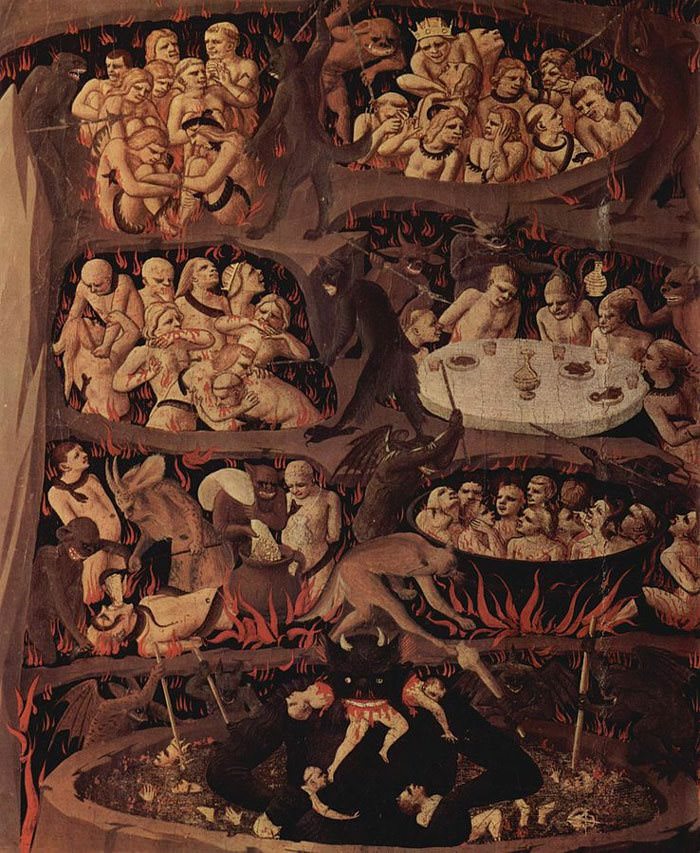
Fra Angelico's The Last Judgment is a tempera painting on panel that was commissioned by the Camaldolese Order for the newly elected abbot, Ambrogio Traversari. The painting is now housed in the San Marco Museum in Florence, Italy, and was previously located in the church of Santa Maria degli Angeli. The exact date of the painting's completion is disputed, with various estimates ranging from 1425 to 1431.
The painting depicts the Christian concept of the Last Judgment, with Christ sitting in judgment, surrounded by angels and saints. The dead rise from their graves to face judgment, with some ascending to heaven and others being condemned to hell. The painting's composition is complex and dynamic, with figures depicted in various poses and gestures to convey different emotions and reactions.
Fra Angelico was a prominent early Renaissance artist and a Dominican friar known for his religious works. His paintings often feature vibrant colors, delicate details, and a focus on spiritual themes. The Last Judgment is considered one of his most significant works, showcasing his mastery of composition, color, and religious symbolism.
#21 The Bewitched Man by Francisco de Goya, 1798
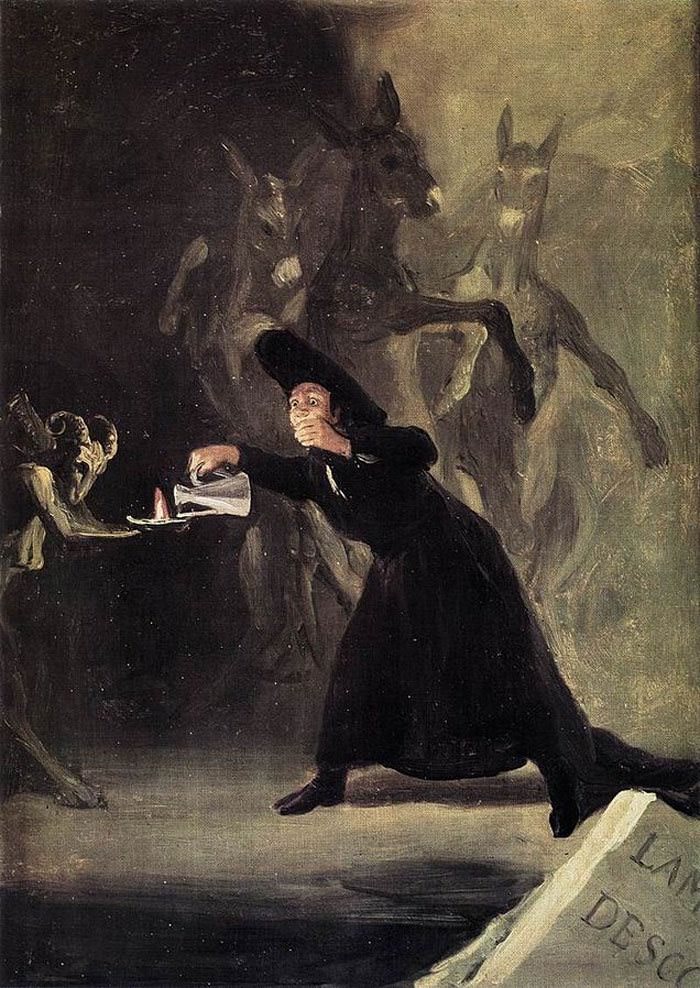
The Bewitched Man, also known as El Hechizado, is an oil on canvas painting created by Francisco de Goya in 1798 during the Romanticism period. The painting depicts a man who has been bewitched and is shown writhing in agony on his bed while surrounded by figures that are likely the witch and her accomplices. The scene is dark and eerie, with an owl perched on a tree branch in the background adding to the ominous atmosphere.
The painting is part of a larger series of works by Goya known as the Black Paintings, which he created on the walls of his own home towards the end of his life. The Black Paintings are known for their dark and disturbing subject matter, and The Bewitched Man is no exception. The painting is thought to be a commentary on the superstitions and beliefs surrounding witchcraft in 18th century Spain. It is currently housed at the Museo del Prado in Madrid, Spain.
#22 The Ghost Of A Flea by William Blak ,1820
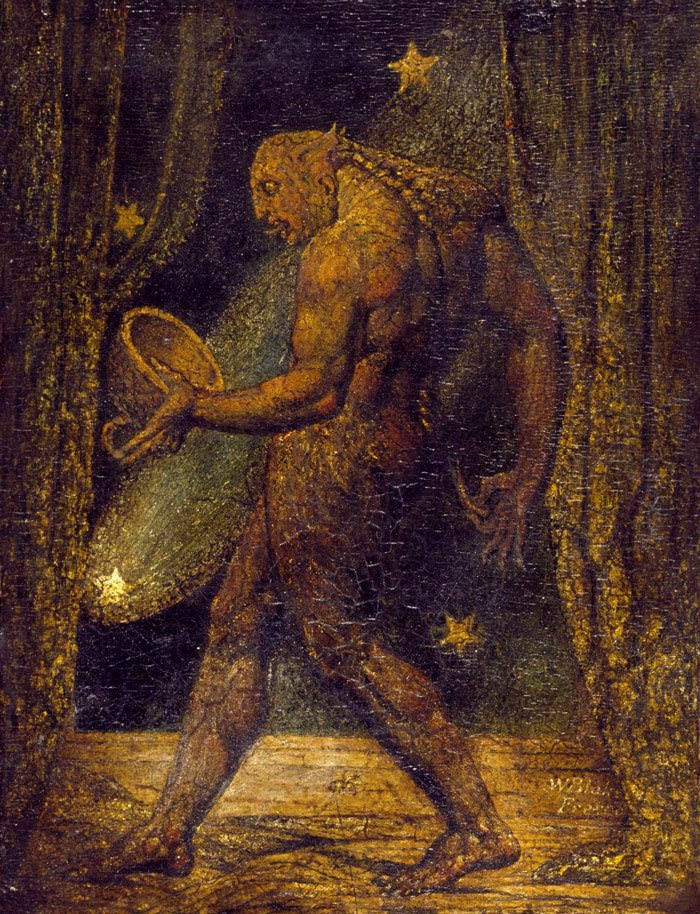
The Ghost of a Flea is a fascinating artwork completed by William Blake in 1820. This unusual painting portrays a demonic-looking creature that Blake believed to be the ghost of a flea he encountered in his home. The creature appears to be gazing at the viewer, with its sharp teeth bared and its muscular arms and legs poised to strike. Blake's use of symbolism in this painting is significant, as the flea represents evil and corruption, which he believed to be present in all humans. The vivid colors, intricate details, and surreal composition of the painting create an eerie and unsettling atmosphere. The Ghost of a Flea is a prime example of Blake's unique artistic vision, blending elements of mysticism, mythology, and horror to produce a truly haunting masterpiece.
#23 The Great Red Dragon and the Woman Clothed with the Sun by William Blake, 1810

"The Great Red Dragon and the Woman Clothed with the Sun" is a painting completed by William Blake in 1810. The artwork is based on the biblical Book of Revelation and depicts the dragon and the woman described in the text. In the painting, the dragon is shown with its seven heads and ten horns, while the woman is depicted standing on the moon with the sun behind her. The image is known for its use of vibrant colors and intricate details.
The painting is part of a series of artworks known as the "Great Red Dragon paintings" that Blake created in the early 19th century. The series includes several different versions of the dragon, each with its unique interpretation. In "The Great Red Dragon and the Woman Clothed with the Sun," the dragon is seen as a symbol of evil, while the woman represents purity and innocence.
The painting has become an iconic image in popular culture, with references appearing in literature, music, and film. Its intricate details and rich symbolism have also made it a subject of study for art historians and scholars of religion and mythology.
#24 Ivan the Terrible and his Son Ivan on November 16th, 1581
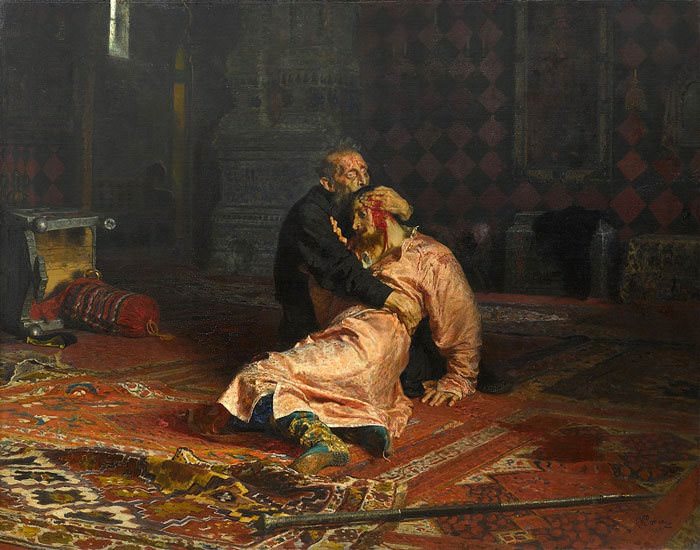
'Ivan The Terrible And His Son Ivan' is a painting by Russian artist Ilya Repin, completed in 1885. The painting depicts an emotional moment in the history of Russia, showing the moment when Ivan the Terrible, the first tsar of Russia, mortally wounded his own son Ivan Ivanovich during an argument in 1581. The painting is renowned for its powerful emotional impact, capturing the horror and tragedy of the scene. The realism style of the painting is evident in the careful attention to detail, with every aspect of the figures and setting rendered with a high degree of accuracy. The painting is often regarded as a masterpiece of Russian art, and it has been the subject of much analysis and interpretation over the years. It is currently housed at the Tretyakov Gallery in Moscow, where it is considered one of the gallery's most important works.
#25 The Witches’ Flight by Francisco Goy, 1798
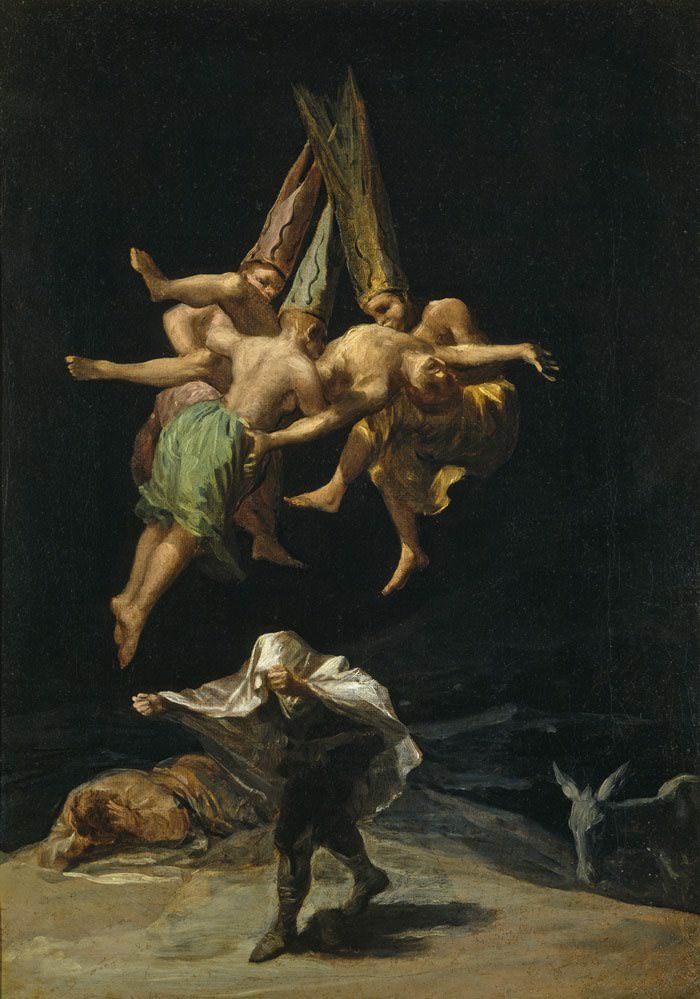
The Witches' Flight is an oil on canvas painting completed by Francisco Goya in 1798, which is part of a series of six paintings related to witchcraft acquired by the Duke and Duchess of Osuna to decorate their villa La Alameda, on the outskirts of Madrid. The painting is now in the collection of the Prado museum.
The central image of the painting features three semi-nude witches wearing penitential coroza, holding up a writhing nude figure. The witches appear to be biting or kissing the figure, as if to devour him or suck his blood. Two figures in peasants' garb are shown recoiling from the scene: one has thrown himself to the ground covering his ears, the other attempts to escape by covering himself with a blanket while making the fig hand gesture to ward off the evil eye. In the background, a donkey emerges on the right, seemingly oblivious to the rest of the scene.
The Witches' Flight is considered one of the most beautiful and powerful of Goya's Osuna witch paintings, and it has been suggested that the painting was meant to criticize the church's authority rather than to depict witchcraft.
#26 The Great Day of his Wrath by John Martin, 1851
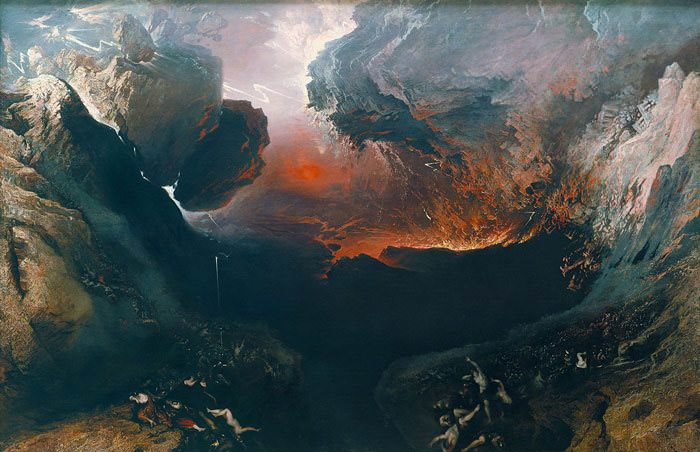
"The Great Day of His Wrath" is a painting created by the English artist John Martin in 1851. The painting depicts the biblical apocalypse as described in the book of Revelation. The painting shows a fiery sky with black clouds, as meteors rain down on the earth. The painting also shows a great earthquake causing the earth to crack and split, while angels sound trumpets and the dead rise from their graves. The painting portrays a sense of chaos and destruction, with cities and buildings in ruins and ships being tossed around in the turbulent sea. The painting is known for its vivid and dramatic portrayal of the end of the world, and has been cited as a masterpiece of Romantic art. The painting is currently held in the Tate Britain gallery in London.
#27 Life and Death by unknown, 17th Century
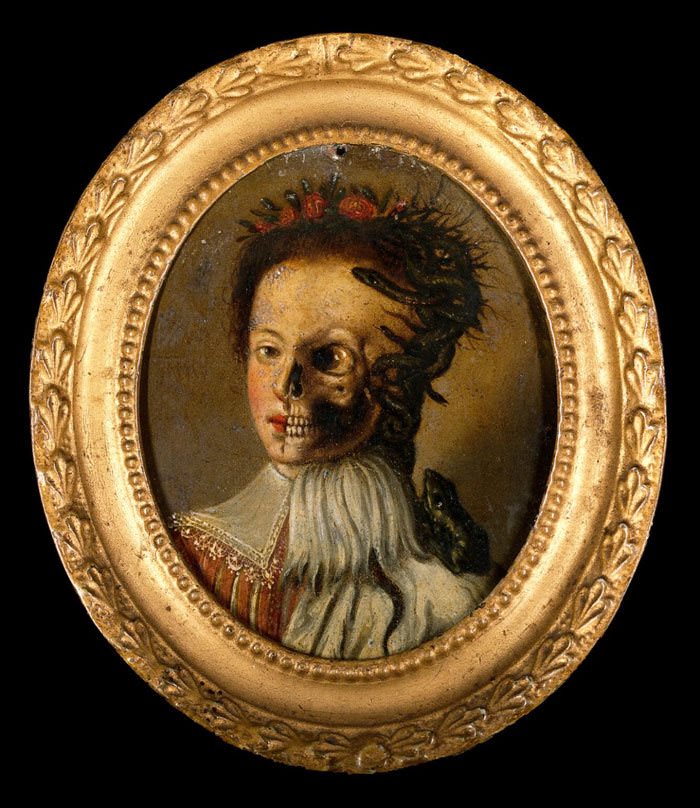
The painting features a young person, possibly a man or a woman, dressed in 17th century Italian clothing, with death consuming their face. The contrast between the bright, healthy-looking cheeks and the sunken, decaying features creates a striking and unsettling image. The exposed teeth and red lips add to the disturbing quality of the painting.
The painting is thought to be an example of the vanitas genre, which was popular in Europe during the 16th and 17th centuries. Vanitas paintings were meant to remind viewers of the transience of life and the inevitability of death. Symbols of decay and mortality, such as skulls, hourglasses, and rotting fruit, were often included in these paintings. "Life and Death" fits in with this tradition, as it features a clear reminder of mortality and the fragility of human life. Despite the lack of information about the painting's origins, it remains a haunting and powerful example of the vanitas genre.
#28 Hell, 1485
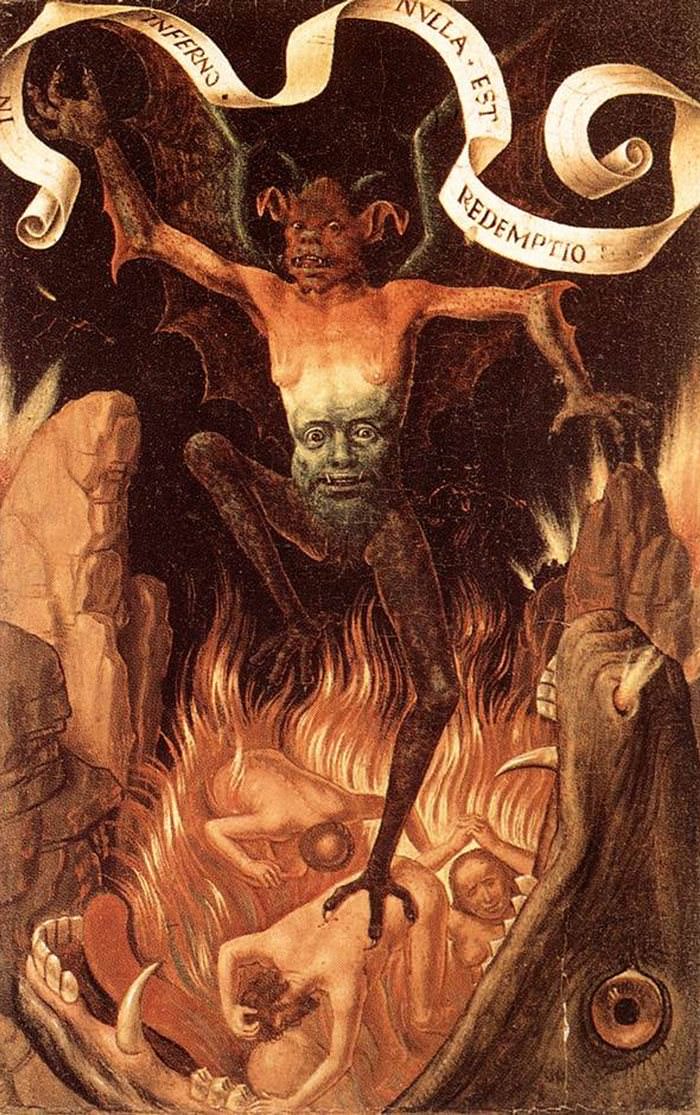
In Hans Memling's Hell, completed in 1485 during the Northern Renaissance, the painting depicts the torments of the damned souls in Hell. The work is divided into two parts, the upper part representing the Last Judgment, while the lower part shows the punishments of the sinners. The painting shows various demons torturing sinners, while the righteous are seen being escorted to Heaven. The demonic figures are portrayed as grotesque and monstrous, with sharp claws and teeth, and appear to be enjoying the suffering of the damned. The souls in Hell are depicted in various poses of agony, including being devoured by demons or submerged in boiling cauldrons. Memling's Hell is an example of the religious themes that were prevalent during the Renaissance and highlights the contrast between good and evil, and the consequences of sin.
#29 The Ambassadors, 1533
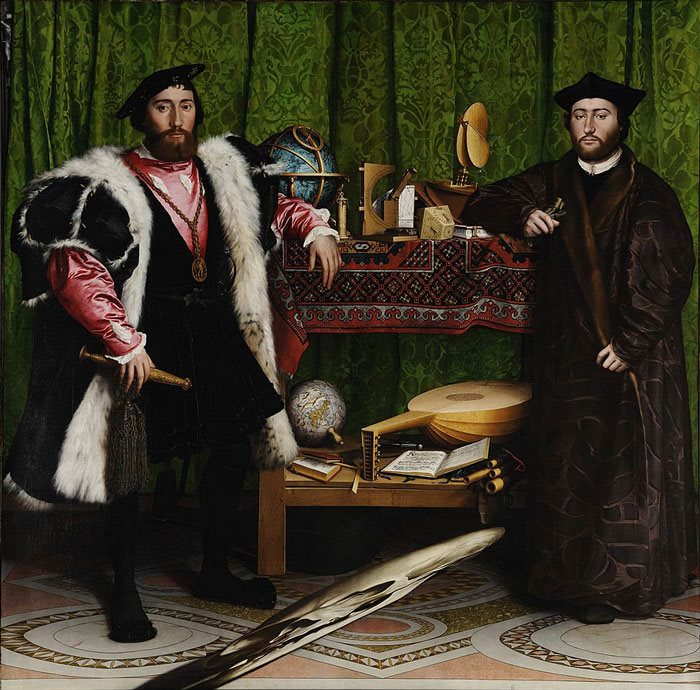
Hans Holbein the Younger's The Ambassadors is a famous painting that features two men, believed to be Jean de Dinteville and Georges de Selve, standing next to a table filled with various objects. One of the most notable elements of the painting is the anamorphic skull that appears in the foreground. The skull is distorted and can only be viewed correctly from a specific angle, a technique known as anamorphosis. The painting is believed to have been created to celebrate the friendship between the two men, who were both diplomats from France, and to demonstrate the intellectual and cultural sophistication of the Renaissance era. The objects on the table, including a globe, a lute, a book, and various scientific instruments, were intended to represent knowledge and culture. The painting is known for its precise detail and realism, which were characteristic of Holbein's style. It is currently housed in the National Gallery in London.
#30 Death of Marat, Jacques-Louis David, 1793

The Death of Marat is an oil painting by French artist Jacques-Louis David, completed in 1793. The painting portrays the murder of Jean-Paul Marat, a prominent figure during the French Revolution, who was assassinated in his bathtub by Charlotte Corday. The painting is a stark portrayal of Marat's death, with him lying slumped in his bathtub and his writing materials scattered around him. The painting was intended to be a propaganda piece, portraying Marat as a martyr for the revolution and inspiring the people to continue their fight against the aristocracy. David used dramatic lighting and composition to create a powerful image that conveys the intensity and urgency of the revolution. The painting is considered a masterpiece of Neoclassical art, and has been described as one of the most famous images of the French Revolution.
#31 The Murderer by Edvard Munch, 1910

Edvard Munch's The Murderer depicts a brutal scene of a man holding a bloody knife and a victim lying dead or dying at his feet. The painting was completed in 1910 and is an example of Munch's Expressionist style, which was characterized by vivid, emotive colors and distorted forms. The scene suggests a sense of horror and violence, while the murderer's face is obscured, leaving the viewer to imagine the killer's identity and motive. The painting is part of a series of works by Munch exploring themes of anxiety, death, and human suffering. It has been interpreted as a commentary on the darker aspects of human nature and the potential for violence in society.
#32 The Triumph of Death, 1562
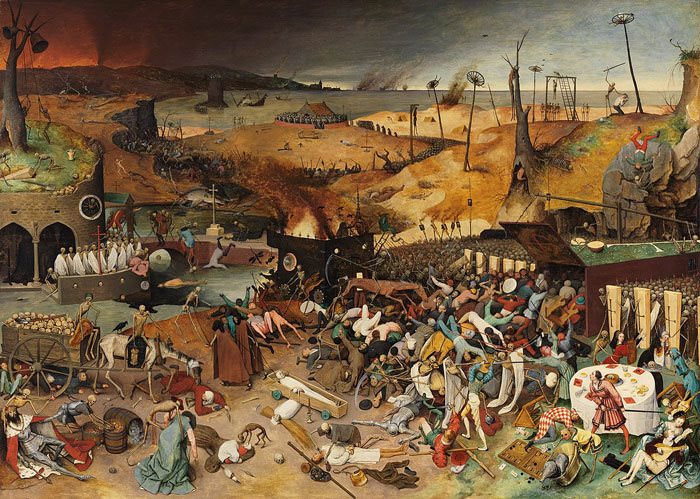
In Pieter Bruegel's The Triumph of Death, we see an apocalyptic scene in which Death personified leads an army of skeletons and demons through a desolate landscape. The painting depicts the final judgement and the end of the world, with the living and the dead being indiscriminately destroyed. The painting is a chilling reminder of the fragility of human life and the inevitability of death. It is also a critique of the violence and wars that plagued Europe during the sixteenth century. The painting is known for its intricate details and the variety of different scenes and characters it portrays. Bruegel's use of light and shadow adds to the eerie atmosphere of the painting, creating a sense of unease and foreboding. The Triumph of Death is considered one of Bruegel's masterpieces and is a powerful example of Northern Renaissance art.
#33 The Scream by Edvard Munch, 1891
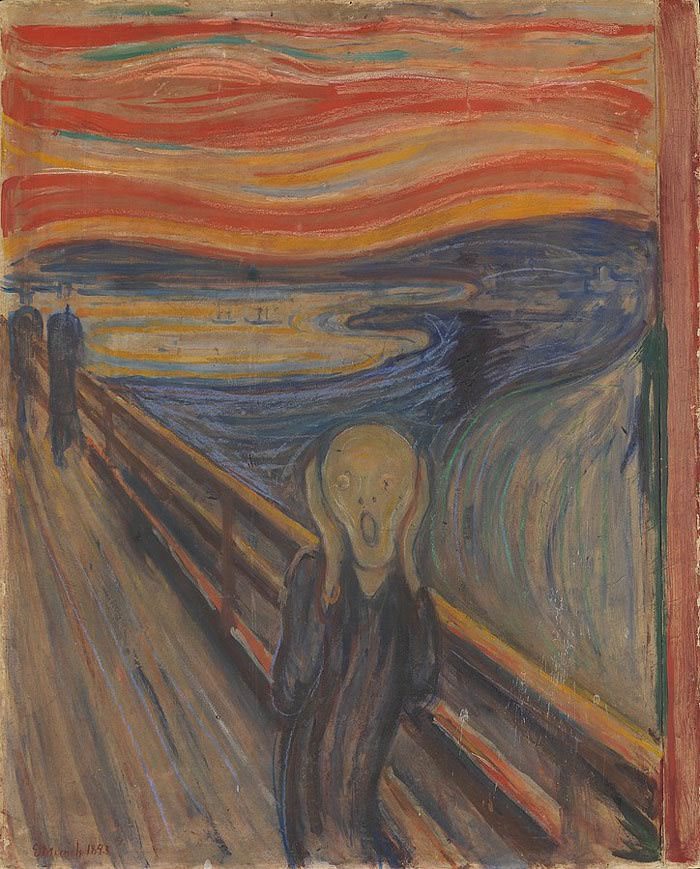
Edvard Munch's The Scream is a renowned painting that epitomizes the existential dread and alienation experienced by many during the early modern era. The painting depicts a person, presumably a man, in agony and covering his ears with his hands, as he is standing on a bridge with a chaotic and blood-red sky in the background. The figure's facial expression conveys a sense of fear and hopelessness, as if he is screaming from the inside out.
The painting is part of a series of four versions, two of which are held at the National Gallery in Oslo, Norway. Munch himself described the inspiration for the painting as a "scream passing through nature," and the work has become an iconic representation of modern angst. The painting's vivid colors and distorted lines convey a sense of turmoil and chaos, and it has been interpreted as a reflection of the artist's own struggles with mental illness and personal turmoil. The Scream is considered a masterpiece of proto-expressionism and has become one of the most recognizable works of art in the world.
#34 The Flaying Of Marsyas, 1576
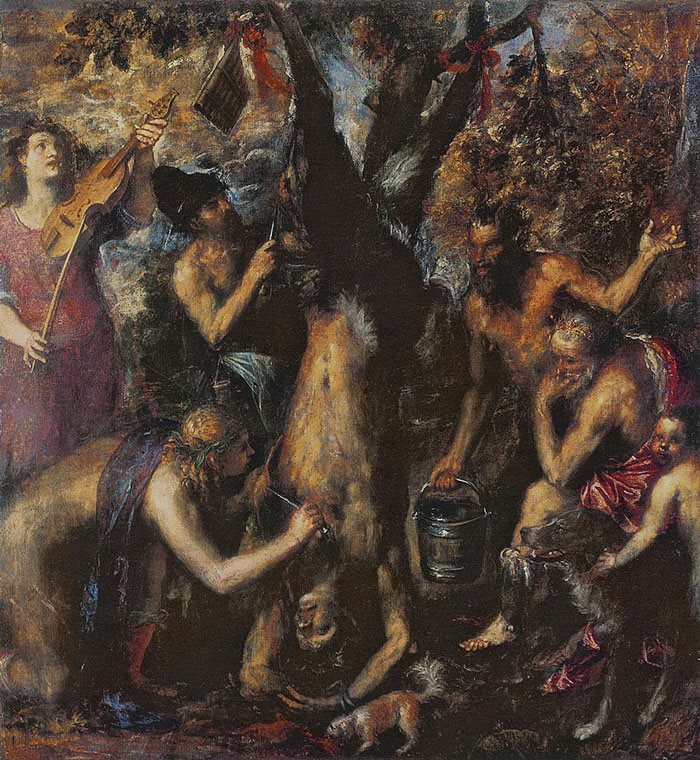
The Flaying of Marsyas by Titian is a painting completed in 1576 during the Mannerist period of art. It depicts the mythological punishment of the satyr Marsyas by the god Apollo for challenging him in a musical contest. In the painting, Marsyas is shown tied to a tree, surrounded by a group of onlookers, while Apollo and his assistants prepare to flay him alive. The painting is known for its vivid depiction of violence and the grotesque nature of Marsyas' punishment, as well as for the complex composition and use of color. It has been interpreted as a reflection on the theme of artistic competition and the struggle for power and dominance, as well as a commentary on the violence and cruelty inherent in human nature. The painting is now part of the collection of the Museo del Prado in Madrid.
#35 Two Old Men Eating Soup by Francisco de Goya, 1823
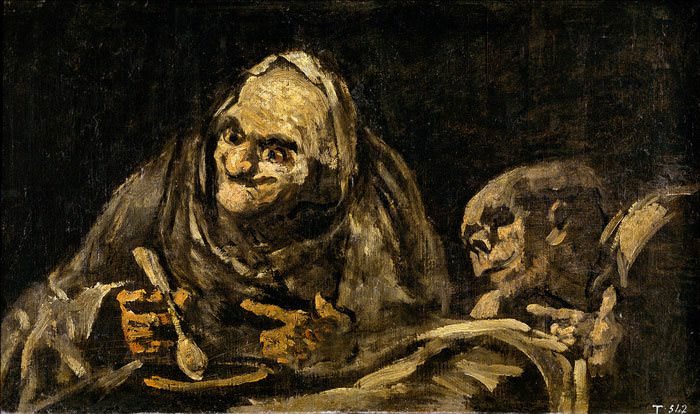
"Two Old Men Eating Soup" is a painting by Francisco de Goya, completed in 1823, during the final years of his life. The painting depicts two elderly men, their wrinkled and weathered faces illuminated by the light of the soup they are eating. The scene is a testament to the harsh realities of poverty and old age, as the two men appear to be struggling to survive.
Goya's use of light and shadow adds a sense of depth and realism to the painting, while the dark and muted colors enhance the somber mood. The painting is a reflection of Goya's own struggles with illness and mortality, as well as a commentary on the social and political climate of Spain at the time.
Despite its seemingly simple subject matter, "Two Old Men Eating Soup" is considered to be one of Goya's most powerful works, a testament to his ability to capture the essence of human emotion and experience. The painting is now housed in the National Gallery of Art in Washington, D.C., where it continues to inspire and move viewers to this day.
#36 Figure With Meat by Francis Bacon, 1954

"Figure with Meat" is a painting created by Francis Bacon in 1954, during the period when he was exploring the theme of animal carcasses and dismembered bodies in his work. The painting depicts a distorted figure seated in a chair, with a large piece of raw meat hanging in front of its face. The figure appears to be screaming in horror or anguish, and its surroundings are distorted and nightmarish. The composition is both disturbing and powerful, conveying a sense of violence and chaos that is typical of Bacon's expressionistic style. The work has been interpreted as a commentary on the human condition and the horrors of war, with the figure representing the vulnerability and fragility of the human body in the face of violence and destruction. The use of raw meat as a symbol of human flesh and mortality is also a recurring motif in Bacon's oeuvre, reflecting his preoccupation with the physical and psychological aspects of human existence.
#37 Le Cyclope by Odilon Redon, 1914
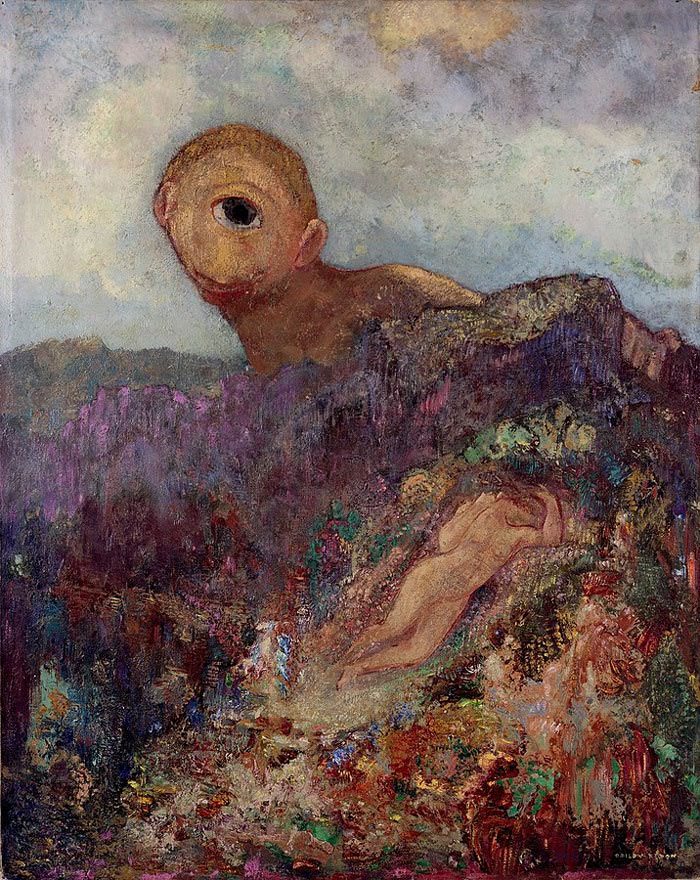
Le Cyclope (The Cyclops) is a painting by French Symbolist artist Odilon Redon, completed in 1914. It portrays a single, large eye gazing out of a dark, shadowy background, with a few small dots of light seemingly reflecting off of it. The eye is surrounded by a rough, organic shape that suggests the form of a face or head, with additional smaller eyes or orbs floating around it. The painting is typical of Redon's fascination with the spiritual and mystical, as well as his exploration of the human psyche through symbolic imagery. In Greek mythology, the Cyclops were one-eyed giants known for their brute strength and violent tendencies, and Redon's use of the singular eye in this painting may be seen as a reference to this mythological figure. The painting's eerie and enigmatic quality, as well as its use of surreal imagery, align it with the Symbolist movement that Redon was associated with.
#38 Aurora Triumphans by Evelyn De Morgan, 1876
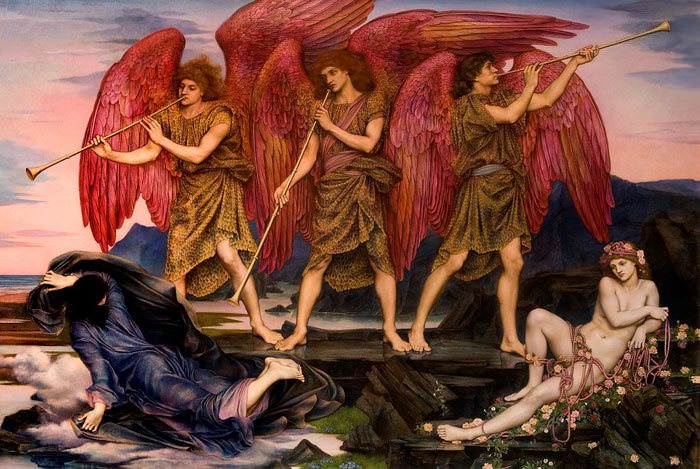
Evelyn De Morgan's Aurora Triumphans is a stunning Pre-Raphaelite painting completed in 1876. The piece depicts the goddess Aurora, the Roman goddess of the dawn, riding across the sky in her chariot, accompanied by cherubs and holding a torch. The painting's vibrant and colorful palette, along with the intricate details in the goddess's flowing hair and garments, creates an ethereal and mystical atmosphere. De Morgan's work is often associated with the Pre-Raphaelite movement due to her interest in mythology and mysticism, and her work's attention to detail and vibrant colors. Aurora Triumphans is a prime example of the movement's love of nature, idealized beauty, and romanticism.
#39 Pyramid Of Skulls by Paul Cézanne, 1901

The Pyramid of Skulls is an oil on canvas painting created by the French artist Paul Cézanne in 1901. The painting features a pile of human skulls stacked in a pyramid shape against a dark, somber background. The painting is a clear departure from Cézanne's earlier Impressionist style, showing a darker and more somber view of the world.
The painting has been interpreted in many different ways, with some critics seeing it as a commentary on the fragility of life, while others see it as a symbol of mortality and the inevitability of death. Some have also seen the painting as a reference to the mass deaths that occurred during the Franco-Prussian War, which took place during the same period in which the painting was created.
Despite its unsettling subject matter, the Pyramid of Skulls is considered a masterpiece of Post-Impressionism, with its bold composition and stark use of color and shadow creating a powerful and haunting image.
#40 The Judgement Of Cambyses by Gerard David, 1487
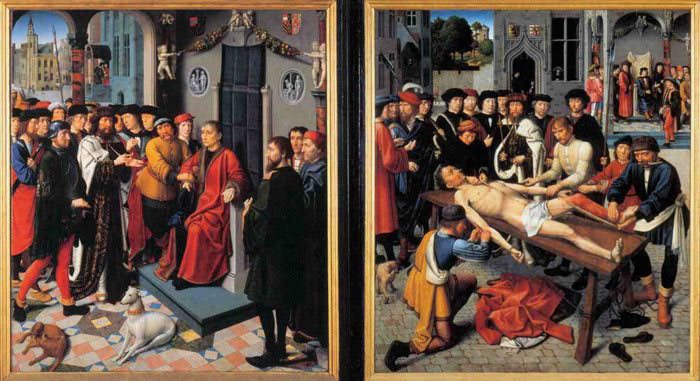
The painting, The Judgement of Cambyses, is a diptych by Dutch artist Gerard David. It was commissioned in 1487/1488 by the municipal authorities of Bruges and depicts the arrest and flaying of the corrupt Persian judge Sisamnes on the order of Cambyses, based on Herodotus' Histories. The painting was used by the town burghers to encourage honesty among magistrates and as a symbolic public apology for the imprisonment of Maximilian I in Bruges in 1488. It is one of the few works by David that is not based on traditional religious themes. The painting is done on oak panels and is now housed at the Groeningemuseum in Bruges, Belgium. There are also other paintings with the same subject by other artists, such as one by Dirck Vellert from 1542.
#41 The Temptation Of St Anthony by Matthias Grünewald, 1521
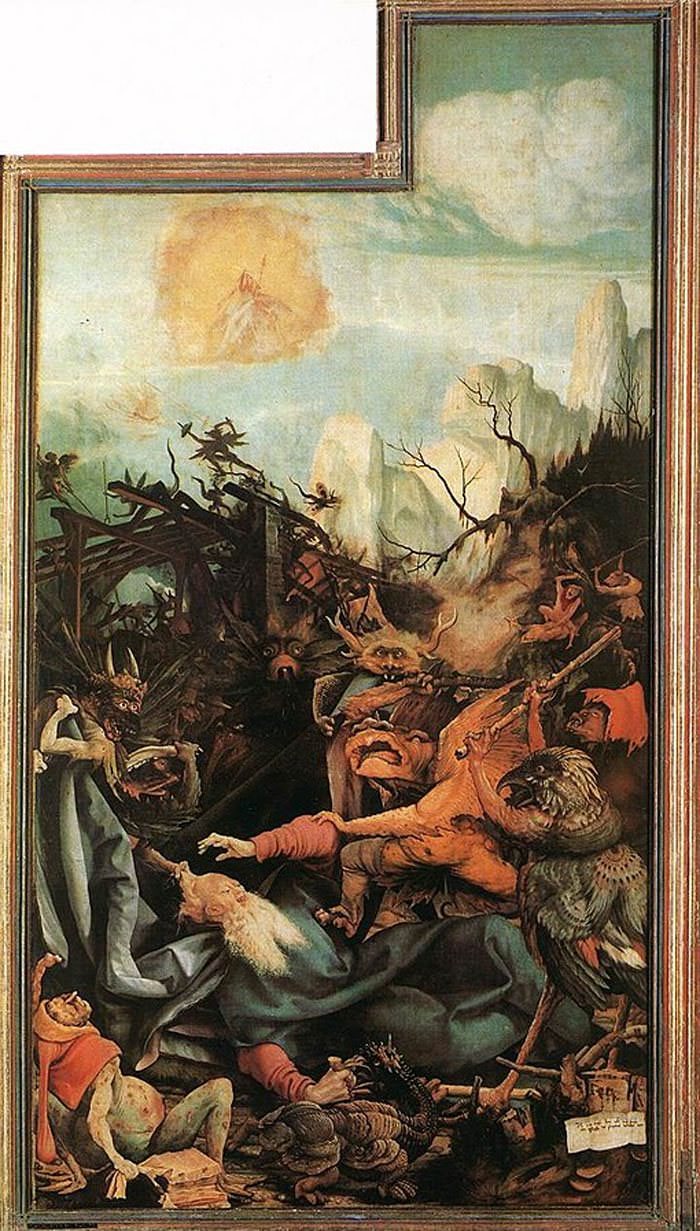
The Temptation of St. Anthony is a painting created by Matthias Grünewald in 1521-1525, and it belongs to the Northern Renaissance period, not Surrealism. The painting portrays the temptations of St. Anthony, a Christian monk who lived in the desert in the 4th century. The scene is depicted as a dream-like and surreal landscape with bizarre creatures and fantastical elements. In the center of the painting, St. Anthony is shown being attacked and tormented by demons in various forms, including anthropomorphic creatures and hybrid monsters.
The painting was originally created as a part of a polyptych altarpiece for the St. Anthony's Monastery in Isenheim, France. The altarpiece was intended to serve as a devotional work for the sick and dying patients of the hospital associated with the monastery. Grünewald's work was considered shocking and disturbing for its time, as it depicted St. Anthony's torment in a graphic and unconventional way. The painting is now part of the collection of the Unterlinden Museum in Colmar, France.
#42 Mask Still Life III by Emil Nolde, 1911

"Mask Still Life III" is a haunting painting created by Emil Nolde, a German Expressionist painter, in 1911. The painting features a collection of masks, each with a unique expression and texture, arranged in a still life composition.
The masks in the painting are twisted and distorted, almost as if they are alive and trapped in a state of agony. The use of vibrant and contrasting colors, such as reds, yellows, and blues, further intensifies the unsettling atmosphere of the painting.
Nolde's use of Expressionism, with its focus on the emotional experience and the distortion of reality, adds to the disturbing nature of the painting. The viewer is left with an uneasy feeling as they try to make sense of the surreal and nightmarish scene.
#43 A Burial at Ornans by Gustave Courbe, 1850
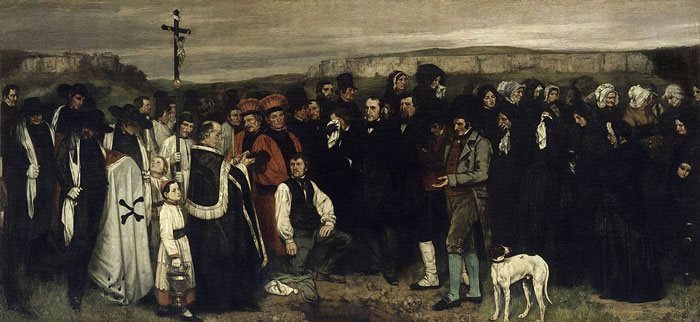
"A Burial At Ornans" is a monumental painting created by Gustave Courbet, a French Realist painter, in 1850. The painting depicts a scene from a funeral in the artist's hometown of Ornans, with the mourners and the deceased arranged in a somber and realistic composition.
The painting's scale and level of detail are impressive, as Courbet sought to capture the raw and unvarnished reality of the scene. The mourners are shown in various states of grief, with some weeping openly and others stoically looking on. The landscape in the background serves to anchor the scene in the rural French countryside, adding a sense of timelessness and permanence to the moment.
What makes "A Burial At Ornans" particularly unsettling is the way in which it challenges traditional ideas of beauty and grandeur in art. Courbet's focus on the mundane and the everyday, rather than the heroic or mythological, was a radical departure from the dominant styles of his time. The painting's unflinching realism and lack of idealization make it a powerful and unsettling work of art.
#44 The Menin Road by Paul Nash, 1919
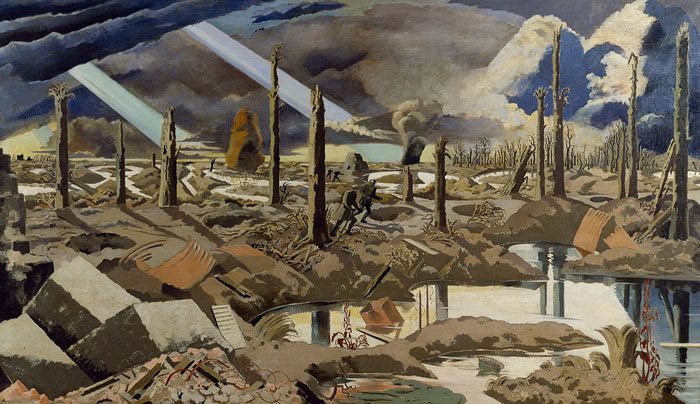
"The Menin Road" is a haunting painting created by British artist Paul Nash in 1919, in the aftermath of World War I. The painting depicts a desolate and otherworldly landscape, with twisted trees and craters scattered throughout. The title refers to a road in Belgium where many British soldiers lost their lives during the war.
Nash's use of Surrealism and Modernism in "The Menin Road" serves to convey the psychological trauma of war. The distorted and dreamlike quality of the painting adds to the sense of disorientation and horror that the soldiers must have experienced on the battlefield. The muted and somber color palette further intensifies the atmosphere of melancholy and despair.
Despite its surrealist qualities, "The Menin Road" is also a modernist work of art, with its focus on the fragmentation and alienation of the individual in the modern world. The painting speaks to the sense of isolation and loss that characterized the aftermath of World War I, as people struggled to make sense of the devastation wrought by the conflict.
#45 Man Proposes, God Disposes by Edwin Landseer, 1864
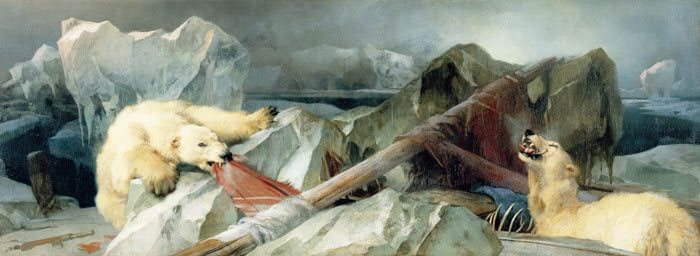
"Man Proposes, God Disposes" is a chilling painting created by British artist Edwin Landseer in 1864. The painting depicts the aftermath of an ill-fated polar expedition, with the remains of the explorers and their equipment scattered across the snowy landscape.
The painting's title is taken from a proverb that reflects the human tendency to make plans and assumptions about the future, only to have them overturned by fate or circumstance. The painting serves as a stark reminder of the dangers of human ambition and the unpredictability of nature.
Landseer's use of realism and attention to detail add to the eerie and unsettling atmosphere of the painting. The frozen corpses of the explorers are shown in graphic detail, with some of them stripped of their clothing and exposed to the elements. The painting's bleak and desolate landscape adds to the sense of isolation and abandonment, as if the explorers were left to their fate by a indifferent universe.
#46 The Dead Mother And Child by Edvard Munch, 1899
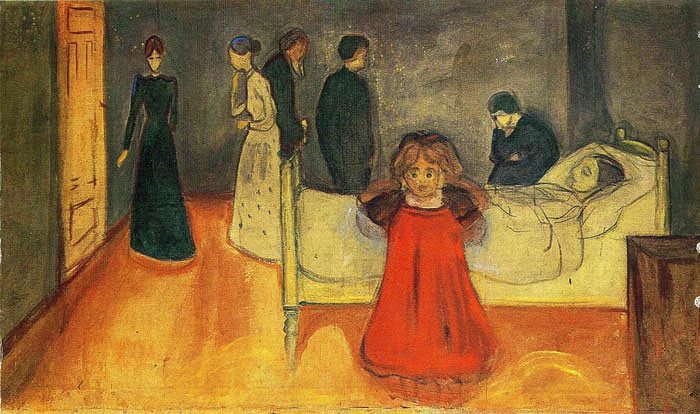
"The Dead Mother and Child" is a harrowing painting created by Norwegian artist Edvard Munch in 1899. The painting depicts a mother and child lying in bed, with the mother dead and the child presumably soon to follow.
Munch's use of proto-Expressionism in the painting serves to convey the intense emotional trauma and psychological pain of the scene. The distorted and exaggerated forms of the figures add to the sense of horror and anguish, while the stark and monochromatic color palette intensifies the mood of despair and grief.
The painting is a powerful commentary on the fragility of life and the inevitability of death. The mother and child are depicted in a moment of extreme vulnerability and helplessness, as they face the finality of their mortality. The painting also speaks to the theme of maternal sacrifice and the bond between mother and child, as the mother is depicted in a final act of nurturing and protection.
#47 The Silver Tureen by Jean-Baptiste-Simeon Chardin, 1730
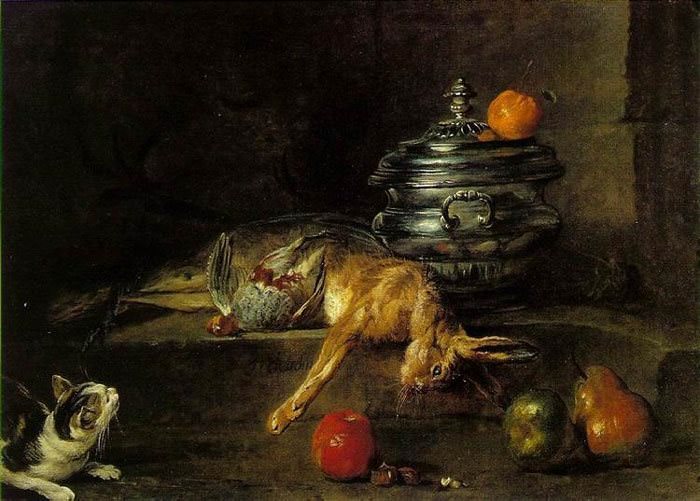
"The Silver Tureen" is a painting created by French artist Jean-Baptiste-Simeon Chardin in 1730. The painting features a silver tureen, or large soup bowl, sitting on a table, surrounded by various other objects such as a pewter jug, an onion, and a loaf of bread.
Despite its seemingly innocuous subject matter, "The Silver Tureen" is a work of art that conveys a sense of foreboding and unease. The painting's use of chiaroscuro, or dramatic contrasts of light and shadow, adds to the atmospheric tension, as if the objects in the painting are imbued with a sense of mystery or even malevolence.
Chardin's use of the Baroque style, characterized by its grandeur and ornate decoration, further intensifies the sense of drama and theatricality in the painting. The attention to detail and the rich textures of the objects in the painting suggest a sense of opulence and luxury, yet there is also a sense of unease and discomfort that permeates the scene.
#48 Diomedes Devoured By His Horses by Gustave Moreau, 1865
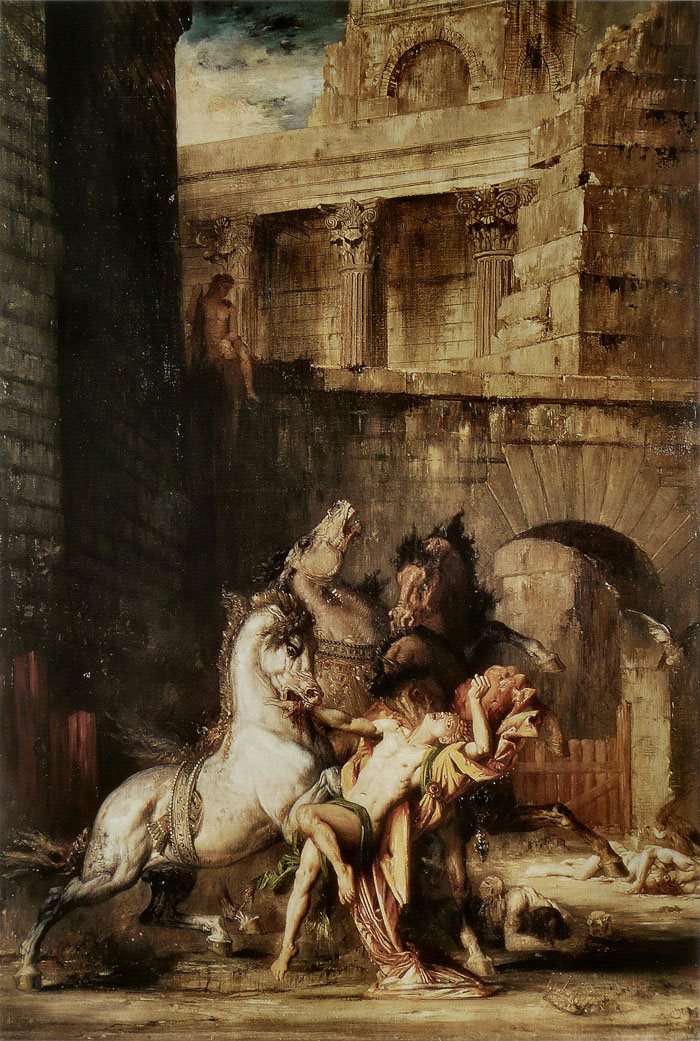
"Diomedes Devoured By His Horses" is a dark and macabre painting created by French artist Gustave Moreau in 1865. The painting depicts the mythological story of Diomedes, a Greek warrior who was fed to his own horses as punishment for stealing their food.
Moreau's use of Symbolism and Modern art in the painting serves to convey the psychological drama and horror of the scene. The twisted and contorted forms of the horses and the gory details of the scene add to the sense of violence and brutality, while the muted and somber color palette intensifies the mood of despair and tragedy.
The painting is a powerful commentary on the destructive forces of human ambition and the consequences of our actions. The story of Diomedes serves as a cautionary tale, reminding us of the dangers of greed and selfishness, and the ultimate price we may pay for our hubris.
#49 The Self Seers (Death And Man) by gon Schiele, 1911
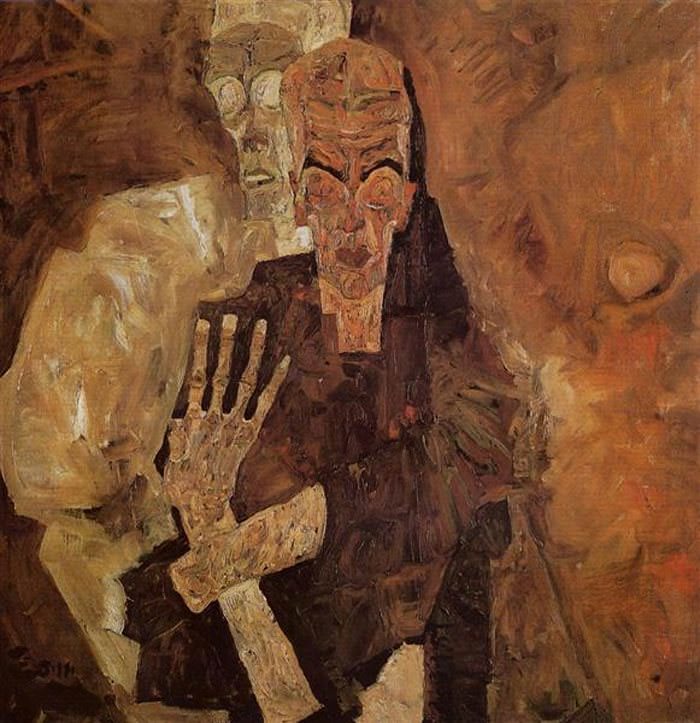
"The Self Seers (Death and Man)" is a powerful and unsettling painting created by Austrian artist Egon Schiele in 1911. The painting features two figures, Death and a man, staring at each other in a confrontational and intense pose.
Schiele's use of Expressionism in the painting serves to convey the psychological tension and emotional turmoil of the scene. The distorted and exaggerated forms of the figures add to the sense of horror and anxiety, while the bold and vibrant color palette intensifies the mood of despair and foreboding.
The painting is a powerful commentary on the inevitability of death and the human fear of mortality. The figures in the painting are shown in a moment of extreme vulnerability and confrontation, as they face the finality of their existence. The painting also speaks to the theme of the human condition, as the figures are depicted in a state of uncertainty and fragility, struggling to come to terms with their place in the world.
#50 American Gothic by Grant Wood, 1930
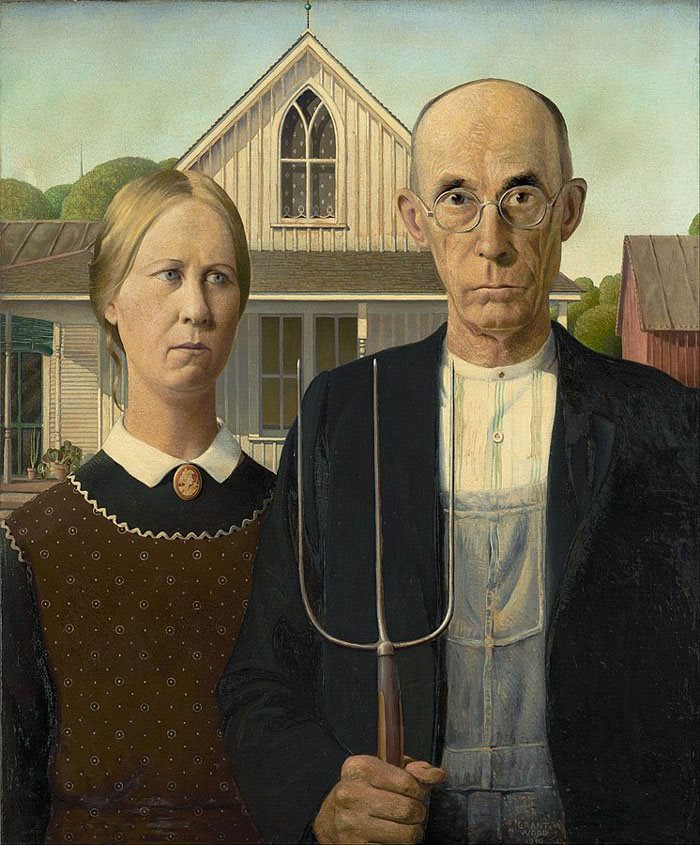
"American Gothic" is a well-known painting created by American artist Grant Wood in 1930. The painting features a stern-looking farmer and his daughter standing in front of a simple white farmhouse with a gothic-style window.
Wood's use of Modernism in the painting is evident in his focus on the ordinary and the everyday, as well as his use of sharp angles and bold lines to create a sense of depth and perspective. The painting is also notable for its attention to detail and the realism of the figures and the landscape.
The painting is a commentary on the Midwestern American experience, particularly the values of hard work, self-sufficiency, and stoicism. The figures in the painting are depicted as proud and resolute, embodying the virtues of the American pioneer spirit.
#51 Guernica by Pablo Picass, 1937
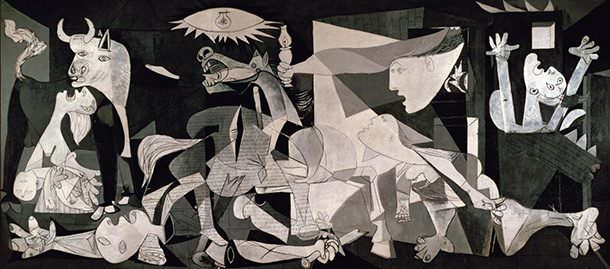
"Guernica" is a masterpiece painting by the Spanish artist Pablo Picasso, completed in 1937. The painting is a political and anti-war statement, depicting the suffering and chaos caused by the bombing of the Spanish town of Guernica during the Spanish Civil War.
Picasso's use of Cubism in the painting serves to convey the psychological horror and fragmentation of the scene. The distorted and fractured forms of the figures and the disorienting angles add to the sense of violence and chaos, while the muted and somber color palette intensifies the mood of despair and tragedy.
The painting is a powerful commentary on the destructive forces of war and the consequences of human conflict. The figures in the painting are shown in a moment of extreme vulnerability and helplessness, as they face the brutality and terror of modern warfare. The painting also speaks to the theme of the human condition, as the figures are depicted in a state of suffering and agony, struggling to survive amidst the chaos and destruction.
#52 Anatomical Pieces by Theodore Gericault
#53 Diomedes Being Eaten by His Horses by Gustave Morea

"Diomedes Being Eaten by His Horses" is a watercolor painting created by French Symbolist painter Gustave Moreau. The painting depicts the climactic scene from the 8th labor of Hercules, in which he is tasked with capturing the flesh-eating horses of King Diomedes.
Moreau's use of Symbolism in the painting serves to convey the psychological drama and horror of the scene. The twisted and contorted forms of the horses and the gory details of the scene add to the sense of violence and brutality, while the bold and vibrant color palette intensifies the mood of despair and foreboding.
The painting is a powerful commentary on the destructive forces of human ambition and the consequences of our actions. The story of Hercules serves as a cautionary tale, reminding us of the dangers of unchecked power and the ultimate price we may pay for our hubris.
#54 Deterioration of Mind Over Matter by Otto Rapp, 1973
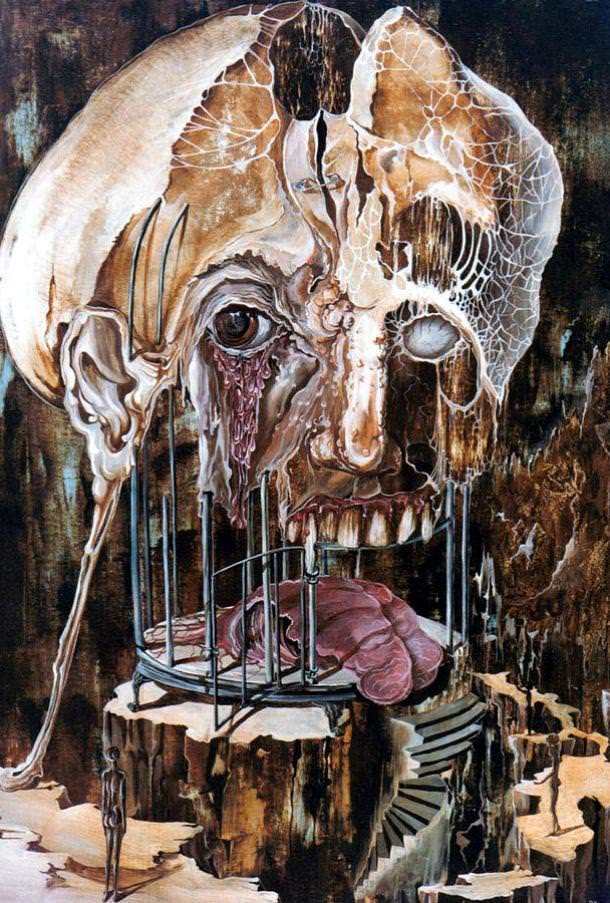
"Deterioration of Mind Over Matter" is a disturbing painting created by Austrian artist Otto Rapp in 1973. The painting features a decomposing human skull hovering over a birdcage, in which the remains of a human body lie lifeless at the base.
Rapp's use of surrealism and symbolism in the painting serves to convey the psychological horror and existential dread of the scene. The twisted and distorted forms of the skull and the birdcage add to the sense of disorientation and dislocation, while the muted and somber color palette intensifies the mood of despair and decay.
The painting is a powerful commentary on the fragility of the human condition and the inevitability of death. The remains of the human body serve as a reminder of our mortality and the ephemeral nature of physical existence. The skull hovering over the scene suggests the transient and illusory nature of the human mind and consciousness.
#55 Dante and Virgil in Hell by William-Adolphe Bouguereau
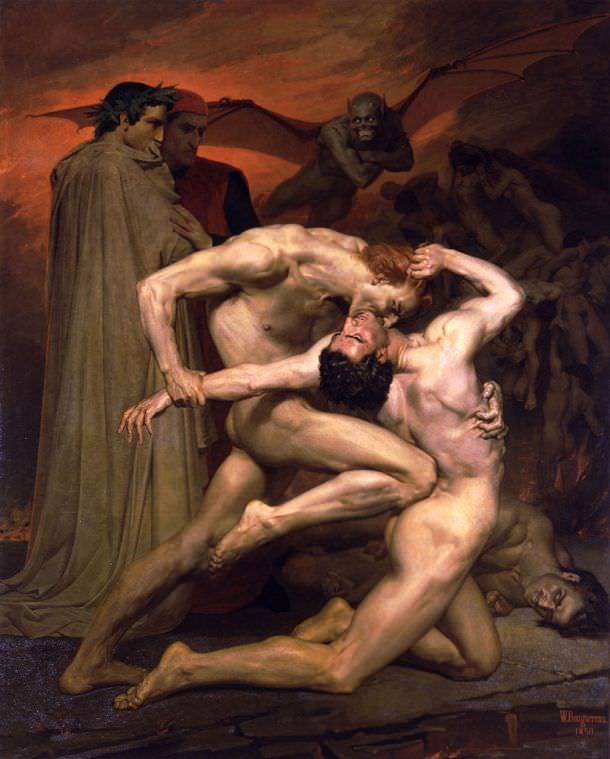
"Dante and Virgil in Hell" is a painting created by French artist William-Adolphe Bouguereau. The painting is based on a scene from Dante's Inferno, where Dante is accompanied by the Roman poet Virgil through the circles of Hell.
Bouguereau's use of realism and neoclassicism in the painting serves to convey the horror and intensity of the scene. The figures of Dante and Virgil are depicted in intricate detail, with their expressions and gestures conveying a sense of awe and terror. The scene of the fight between the damned souls is depicted with a remarkable sense of drama and movement, with the figures twisting and contorting in agony and despair.
The painting is a powerful commentary on the human condition and the consequences of our actions. The figures in the painting are shown in a moment of extreme vulnerability and punishment, as they face the ultimate consequences of their sins. The painting also speaks to the theme of human redemption, as Dante and Virgil journey through the circles of Hell in search of salvation and spiritual enlightenment.
#56 A Negro Hung Alive
#57 Big Electric Chair by Andy Warhol, 1967
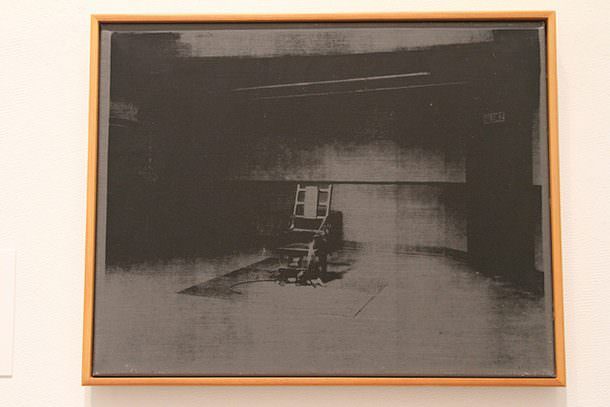
"Big Electric Chair" is a painting created by American pop art artist Andy Warhol in 1967. The painting is part of a series of works by Warhol that depict electric chairs, a symbol of death and violence.
Warhol's use of pop art in the painting serves to highlight the stark and brutal reality of capital punishment. The image of the electric chair is rendered in bright and bold colors, drawing attention to its significance as an instrument of death and power.
The painting is a commentary on the dark side of American culture and the human fascination with violence and death. The image of the electric chair serves as a symbol of the horrors of the modern world, a reminder of the human capacity for cruelty and destruction.
#58 Hell by Hans Memling, 1485
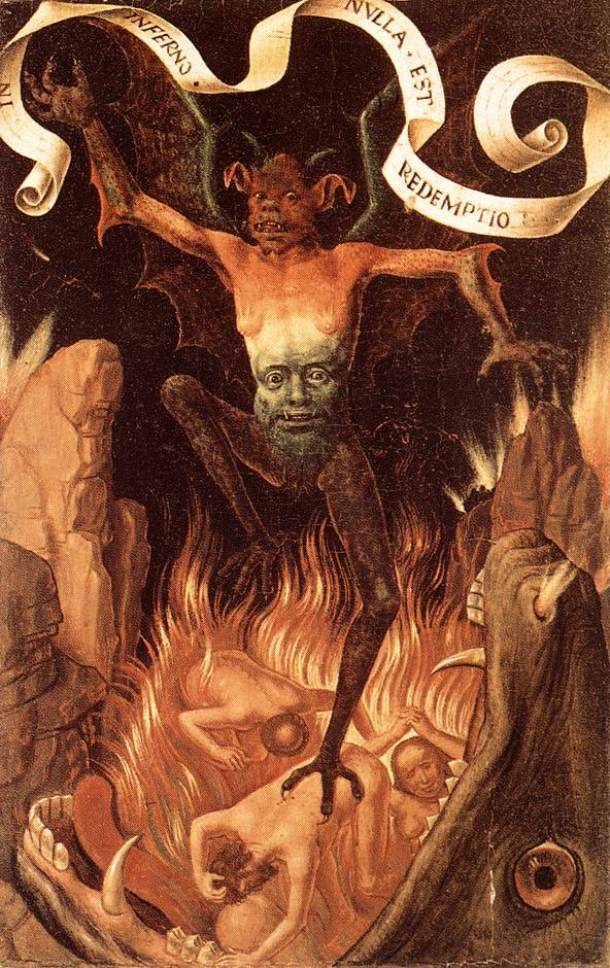
"Hell" is a painting created by German artist Hans Memling in 1485. The painting is a representation of the Christian concept of Hell, and depicts the torments of the damned souls in vivid and terrifying detail.
Memling's use of realism and intricate detail in the painting serves to convey the horror and intensity of the scene. The figures of the damned souls are depicted in various states of agony and despair, with their expressions and gestures conveying a sense of terror and hopelessness. The addition of the banner reading "In hell there is no redemption" intensifies the mood of despair and finality.
The painting was created during a time when the Church used the threat of eternal damnation to compel people to live virtuous lives. "Hell" was intended as a warning to the faithful, a reminder of the consequences of sin and the need for moral rectitude.
#59 The Water Ghost by Alfred Kubin
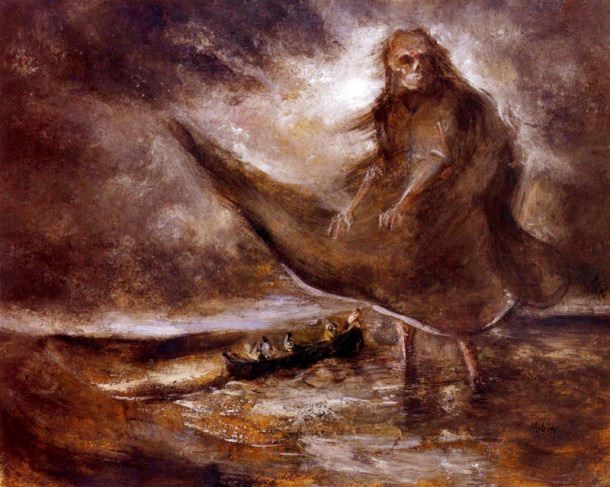
"The Water Ghost" is a haunting and surrealistic painting created by Austrian artist Alfred Kubin. The painting features a dark and foreboding sea scene, with a ghostly figure emerging from the depths.
Kubin's use of symbolism and expressionism in the painting serves to convey the psychological tension and emotional turmoil of the scene. The twisted and distorted forms of the figures add to the sense of horror and anxiety, while the muted and somber color palette intensifies the mood of despair and foreboding.
The painting is a commentary on the human fear of the unknown and the destructive forces of nature. The figure of the water ghost serves as a symbol of the power and unpredictability of the sea, as well as a metaphor for the haunting and often unconscious fears that plague the human psyche.
#60 Study after Velazquez’s Portrait of Pope Innocent X by Francis Bacon, 1953
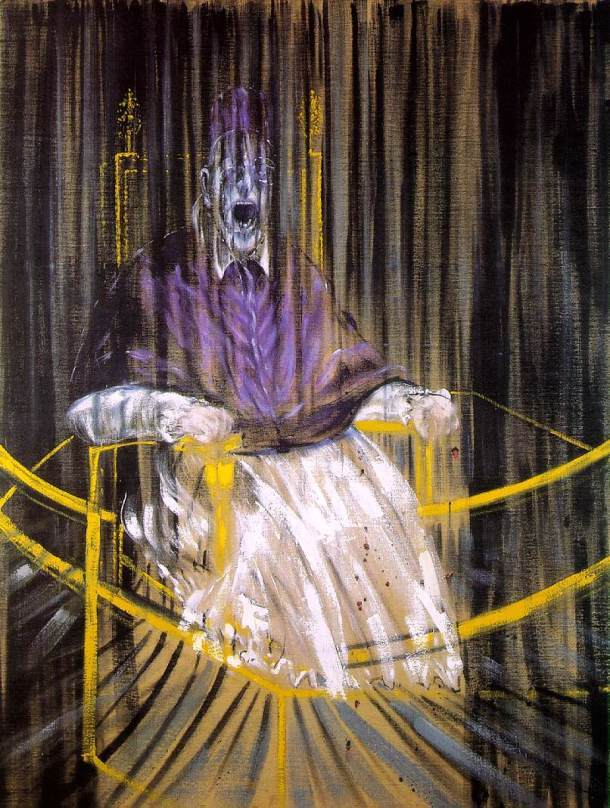
"Study after Velazquez's Portrait of Pope Innocent X" is a famous painting created by British artist Francis Bacon in 1953. The painting is part of a series of works by Bacon that are based on Diego Velazquez's 1650 portrait of Pope Innocent X.
Bacon's use of expressionism and abstraction in the painting serves to convey the psychological intensity and emotional turmoil of the scene. The figure of the Pope is depicted in a state of extreme agitation, with his mouth open in a scream and his features twisted in horror. The dark and blurry background adds to the sense of disorientation and dislocation, intensifying the mood of terror and despair.
The painting is a commentary on the human condition and the darker aspects of human nature. The figure of the Pope serves as a symbol of the corruption and hypocrisy of institutional power, as well as a reminder of the suffering and pain that often accompany human existence.
#61 Necronom IV by H.R. Giger.
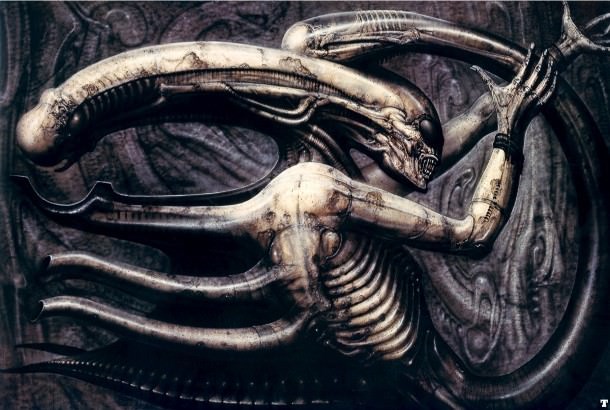
"Necronom IV" is a terrifying painting created by Swiss artist H.R. Giger. The painting features a dark and disturbing creature with elongated limbs, sharp teeth, and otherworldly features.
Giger's use of surrealism and horror in the painting serves to convey the psychological terror and emotional turmoil of the scene. The twisted and distorted forms of the creature add to the sense of horror and anxiety, while the muted and somber color palette intensifies the mood of despair and foreboding.
The painting is a commentary on the human fear of the unknown and the destructive forces of the universe. Giger's works are often inspired by his experiences with night terrors and sleep disorders, and "Necronom IV" is no exception. The creature depicted in the painting serves as a manifestation of the dark and frightening creatures that haunt our dreams and nightmares.
#62 The Temptation of Saint Anthony by Matthias Grunewald
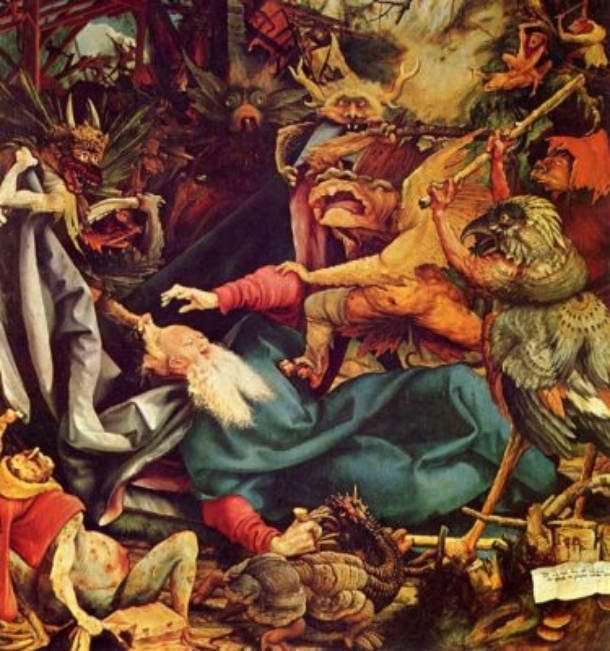
"The Temptation of Saint Anthony" is a powerful and intense painting created by German Renaissance artist Matthias Grunewald. The painting depicts the story of Saint Anthony, a Christian monk who was tempted by demons and otherworldly beings during his time of solitude in the desert.
Grunewald's use of symbolism and expressionism in the painting serves to convey the psychological tension and emotional turmoil of the scene. The twisted and distorted forms of the demons and otherworldly beings add to the sense of horror and anxiety, while the muted and somber color palette intensifies the mood of despair and foreboding.
The painting is a commentary on the human struggle against temptation and the power of spiritual enlightenment. Saint Anthony is depicted as a symbol of the human capacity for spiritual transcendence, while the demons and otherworldly beings represent the forces of darkness and temptation that seek to derail our spiritual journey.
#63 The Flaying of Marsyas by Titian
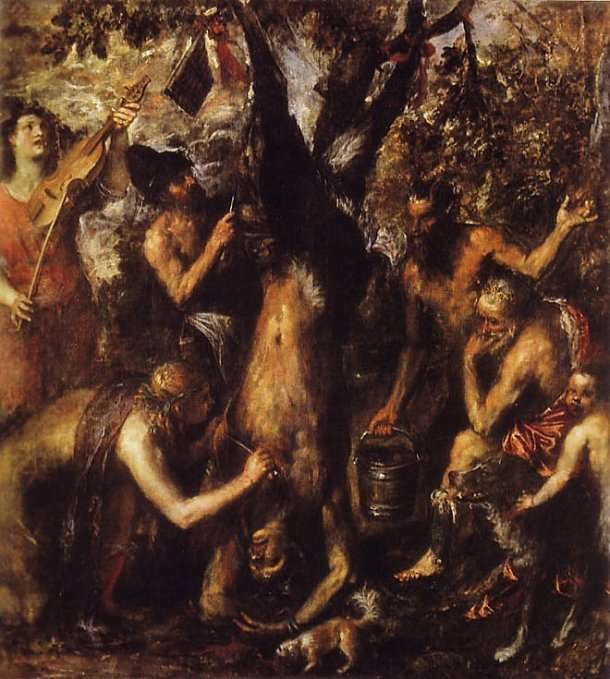
"The Flaying of Marsyas" is a powerful and intense painting created by Italian Renaissance artist Titian. The painting depicts the brutal and graphic scene from Greek mythology where the satyr Marsyas is being flayed alive as a punishment for his hubris in challenging the god Apollo in a musical contest.
Titian's use of realism and vivid detail in the painting serves to convey the horror and intensity of the scene. The figures of Marsyas and Apollo are depicted in intricate detail, with their expressions and gestures conveying a sense of awe and terror. The scene of the flaying is depicted with a remarkable sense of drama and movement, with the figures twisting and contorting in agony and despair.
The painting is a commentary on the human condition and the consequences of our actions. The figures in the painting are shown in a moment of extreme vulnerability and punishment, as they face the ultimate consequences of their hubris and pride. The painting also speaks to the theme of human mortality and the inevitability of death, as the figure of Marsyas is shown in a state of ultimate vulnerability and powerlessness.
#64 The Scream by Edvard Munch, 19th Century
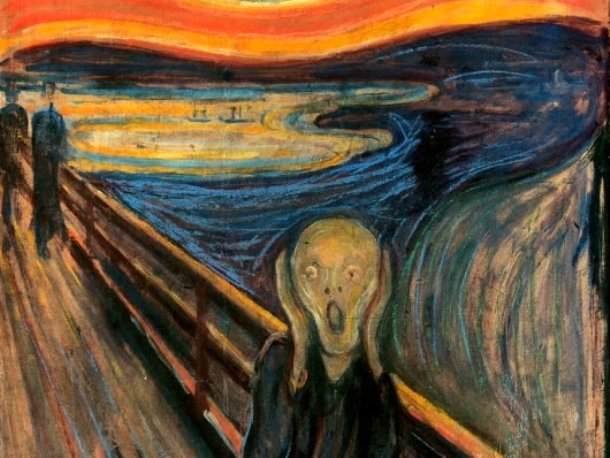
"The Scream" is a powerful and iconic series of paintings and prints created by Norwegian artist Edvard Munch in the late 19th century. The paintings depict a haunting and twisted figure against a backdrop of a blood-red sky.
Munch's use of expressionism and abstraction in the painting serves to convey the psychological tension and emotional turmoil of the scene. The twisted and distorted forms of the figure add to the sense of horror and anxiety, while the vivid and vibrant colors intensify the mood of despair and foreboding.
The painting is a commentary on the human condition and the darker aspects of human nature. Munch was deeply influenced by his own experiences of loss, trauma, and psychological distress, and "The Scream" is a reflection of these themes. The figure in the painting serves as a symbol of the human capacity for despair and terror, as well as a reminder of the power of nature and the human need for emotional and psychological release.
#65 Gallowgate Lard by Ken Currie
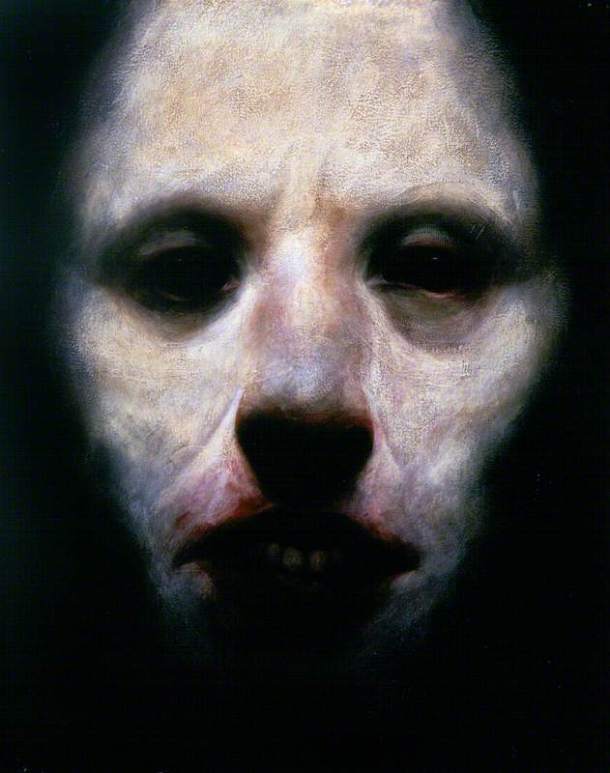
"Gallowgate Lard" is a powerful and intense oil painting created by Scottish artist Ken Currie. The painting depicts a figure that is believed to be a self-portrait of the artist, against a backdrop of a bleak and desolate urban landscape.
Currie's use of realism and vivid detail in the painting serves to convey the horror and intensity of the scene. The figure in the painting is depicted with a remarkable sense of detail, with his gaunt and emaciated features conveying a sense of despair and hopelessness. The bleak and desolate landscape adds to the mood of despair and foreboding, intensifying the sense of the harsh realities of working-class life.
The painting is a commentary on the human condition and the darker aspects of urban life. Currie specialized in depicting the bleak realities of Scottish working-class life, and "Gallowgate Lard" is a reflection of these themes. The figure in the painting serves as a symbol of the human capacity for endurance and perseverance in the face of adversity, as well as a reminder of the power of art to confront and challenge the injustices of society.
#66 Saturn Devouring His Son by Francisco Goya, 1820s
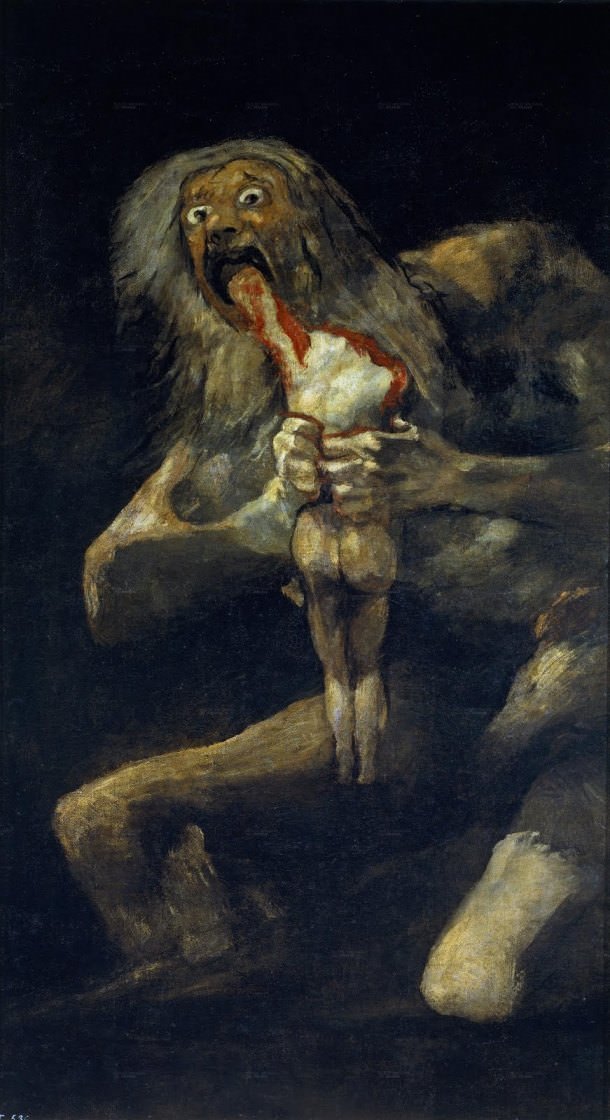
"Saturn Devouring His Son" is a haunting and intense painting created by Spanish artist Francisco Goya between 1820 and 1823. The painting depicts the scene from Greek mythology where the Titan Chronus (Romanized to Saturn) is shown devouring one of his own children.
Goya's use of realism and vivid detail in the painting serves to convey the horror and intensity of the scene. The figure of Saturn is depicted with a sense of barbarism and madness, with his wild eyes and bloody hands conveying a sense of terror and despair. The distorted and twisted form of the figure adds to the sense of horror and anxiety, while the muted and somber color palette intensifies the mood of despair and foreboding.
The painting is a commentary on the darker aspects of human nature and the destructive forces of power and authority. Saturn is depicted as a symbol of the human capacity for violence and cruelty, as well as a reminder of the destructive nature of unchecked power and authority. The painting also speaks to the theme of human mortality and the inevitability of death, as the figure of Saturn is shown in a state of ultimate vulnerability and powerlessness.
#67 Death and the Miser by Hieronymus Bosch

"Death and the Miser" is a haunting and powerful painting created by Dutch artist Hieronymus Bosch. The painting depicts the scene of a miser who is visited by Death, reminding him of the inevitability of his own mortality.
Bosch's use of symbolism and surrealism in the painting serves to convey the horror and intensity of the scene. The figure of Death is depicted with a sense of menace and foreboding, while the figure of the miser is shown in a state of fear and despair. The various objects and symbols in the painting add to the sense of horror and anxiety, while the muted and somber color palette intensifies the mood of despair and foreboding.
The painting is a commentary on the human condition and the inevitability of death. The figure of the miser serves as a symbol of the human capacity for greed and materialism, while the figure of Death serves as a reminder of the ultimate futility of earthly possessions and the need for spiritual enlightenment. The painting also speaks to the theme of human mortality and the inevitability of death, as the figure of Death is shown as an unrelenting force that will eventually claim us all.
#68 Judith Beheading Holofernes by Caravaggio, 1599
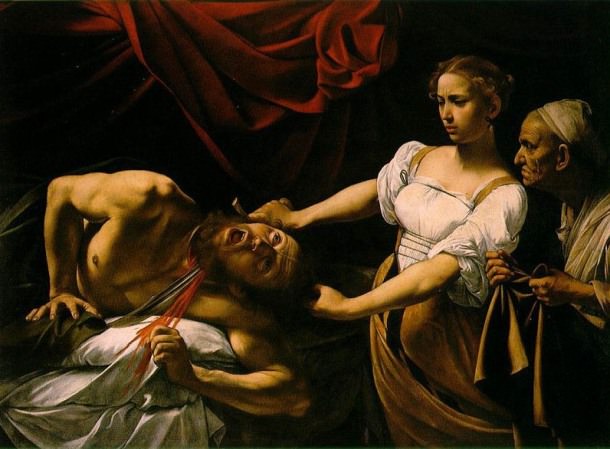
"Judith Beheading Holofernes" is a powerful and intense painting created by Italian Baroque artist Caravaggio in 1599. The painting depicts the scene from the Book of Judith in which Judith beheads the Assyrian general Holofernes.
Caravaggio's use of realism and vivid detail in the painting serves to convey the horror and intensity of the scene. The figure of Judith is depicted with a sense of strength and determination, with her intense gaze and muscular arms conveying a sense of power and courage. The figure of Holofernes is shown in a state of terror and despair, with his twisted and contorted features adding to the sense of horror and anxiety.
The painting is a commentary on the human condition and the darker aspects of human nature. Judith is depicted as a symbol of the human capacity for bravery and heroism, as well as a reminder of the need for courage and determination in the face of adversity. The painting also speaks to the theme of human mortality and the inevitability of death, as the figure of Holofernes is shown in a state of ultimate vulnerability and powerlessness.
#69 Heads Severed by Theodore Gericault, 1818
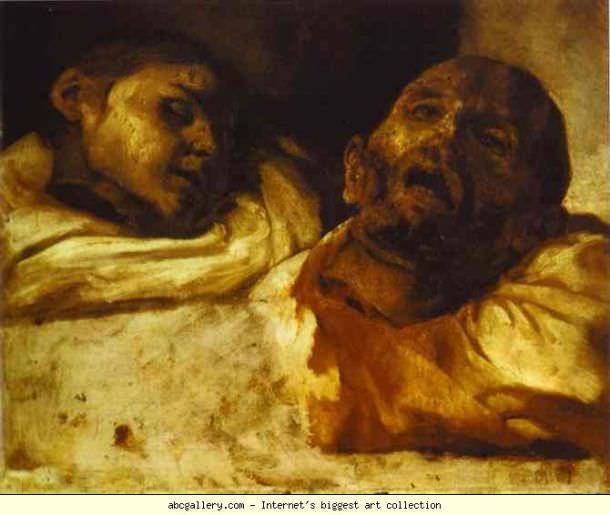
"Heads Severed" is a powerful and intense painting created by French painter Theodore Gericault in 1818. The painting depicts a scene of severed heads, displayed in a gruesome and disturbing manner.
Gericault's use of realism and vivid detail in the painting serves to convey the horror and intensity of the scene. The severed heads are depicted with a sense of gore and morbidity, with their twisted and contorted features adding to the sense of horror and anxiety. The muted and somber color palette intensifies the mood of despair and foreboding.
The painting is a commentary on the darker aspects of human nature and the destructive forces of power and authority. The severed heads serve as a symbol of the human capacity for violence and cruelty, as well as a reminder of the destructive nature of unchecked power and authority. The painting also speaks to the theme of human mortality and the inevitability of death, as the figure of the severed heads is shown in a state of ultimate vulnerability and powerlessness.
#70 Massacre of the Innocents by Peter Paul Rubens, 1612
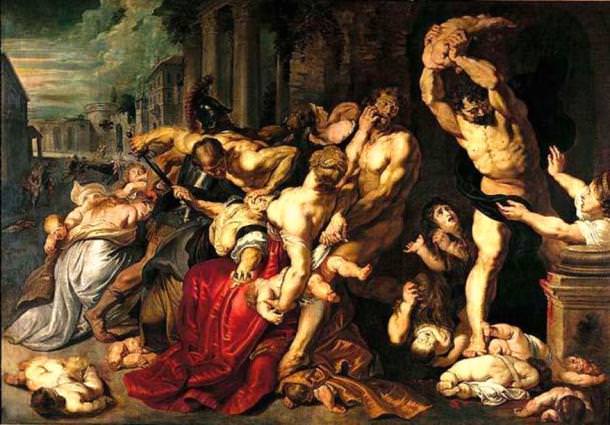
"Massacre of the Innocents" is a powerful and intense artwork created by Flemish Baroque artist Peter Paul Rubens in 1612. The artwork consists of two paintings that depict the scene from the Gospel of Matthew in which King Herod orders the massacre of all male infants in Bethlehem.
Rubens' use of vivid detail and dramatic lighting in the painting serves to convey the horror and intensity of the scene. The figures of the mothers and children are depicted with a sense of terror and despair, with their twisted and contorted features adding to the sense of horror and anxiety. The muted and somber color palette intensifies the mood of despair and foreboding.
The artwork is a commentary on the darker aspects of human nature and the destructive forces of power and authority. King Herod is depicted as a symbol of the human capacity for violence and cruelty, as well as a reminder of the destructive nature of unchecked power and authority. The artwork also speaks to the theme of human mortality and the inevitability of death, as the figures of the slaughtered infants and their grieving mothers are shown in a state of ultimate vulnerability and powerlessness.
#71 The Disasters of War Francisco Goya, 1810s
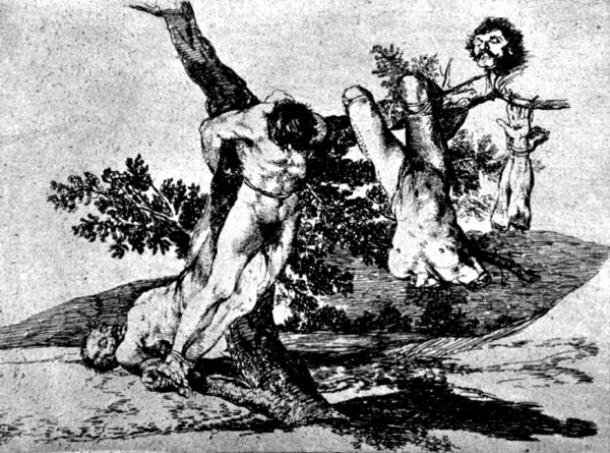
"The Disasters of War" is a powerful and intense series of prints created by Spanish painter Francisco Goya between 1810 and 1820. The series consists of 82 prints that depict the horrors and atrocities of war, including scenes of violence, torture, and death.
Goya's use of vivid detail and dramatic imagery in the prints serves to convey the horror and intensity of war. The figures are depicted with a sense of terror and despair, with their twisted and contorted features adding to the sense of horror and anxiety. The stark and dark color palette intensifies the mood of despair and foreboding.
The series is a commentary on the darker aspects of human nature and the destructive forces of war. Goya is depicted as a symbol of the human capacity for violence and cruelty, as well as a reminder of the destructive nature of war. The prints also speak to the theme of human mortality and the inevitability of death, as the figures are shown in a state of ultimate vulnerability and powerlessness.
#72 Big Electric Chair by Andy Warhol

"Big Electric Chair" is a striking and provocative artwork created by the American artist Andy Warhol in 1967. It is part of a series of works by Warhol that depict an electric chair, a symbol of the death penalty and state-sanctioned violence.
Warhol's use of bright and bold colors in the painting serves to highlight the stark and unsettling nature of the subject matter. The electric chair itself is depicted with a sense of foreboding and ominous power, while the empty room in which it is situated adds to the sense of loneliness and isolation.
The artwork is a commentary on the darker aspects of human nature and the destructive forces of power and authority. Warhol is depicted as a symbol of the human capacity for violence and cruelty, as well as a reminder of the destructive nature of the state and its power over individuals.
#73 A Puppet for the Niece by Santiago Caruso
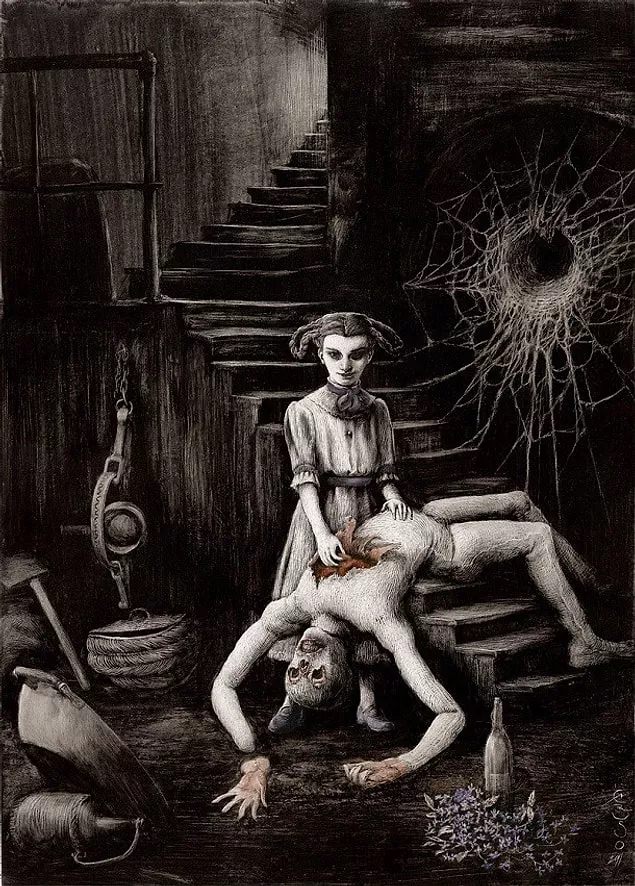
"A Puppet for the Niece" is a haunting and macabre artwork created by the Argentine artist Santiago Caruso. The piece is a black-and-white symbolic illustration that depicts a puppet, presumably for a niece, that is being manipulated by an unseen force.
Caruso's use of limited color and strong contrast in the illustration serves to create a sense of foreboding and unease. The figure of the puppet is depicted with a twisted and contorted expression, while the hand that is manipulating it is hidden in darkness, adding to the sense of mystery and dread.
The artwork is a commentary on the darker aspects of human nature and the power dynamics that exist within relationships. The figure of the puppet is a symbol of the human capacity for manipulation and control, while the unseen hand represents the hidden forces that influence our lives.
#74 “Grave Goods by Jeff Christensen

"Grave Goods" is a thought-provoking artwork created by the American artist Jeff Christensen. The painting depicts a collection of objects that are typically associated with death, such as skulls, candles, and funeral urns.
Christensen's use of muted colors and somber lighting in the painting serves to create a sense of solemnity and reverence. The objects are arranged in a symmetrical composition, adding to the sense of order and structure.
The artwork is a commentary on the human experience of death and the ways in which we seek to remember and honor those who have passed. The objects in the painting are symbols of the human desire to preserve and memorialize the dead, while the title "Grave Goods" suggests that our mortality is a fundamental aspect of our existence.
#75 A New You Could be Born Today by Santiago Caruso
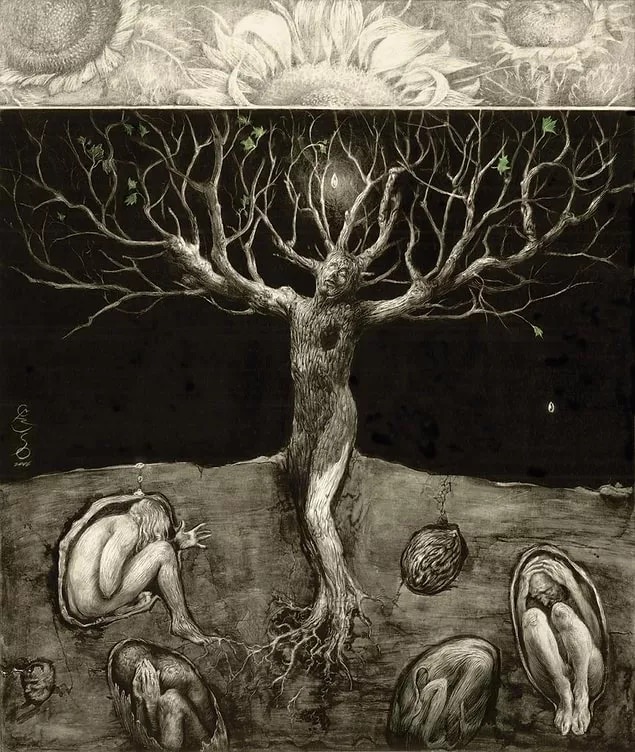
"A New You Could be Born Today" is an intense and apocalyptic artwork created by Argentine artist Santiago Caruso. The painting depicts a figure emerging from a cocoon-like structure against a backdrop of destruction and chaos.
Caruso's use of a limited color palette and strong contrast serves to create a sense of foreboding and tension in the painting. The figure emerging from the cocoon is depicted with a sense of rebirth and transformation, while the destruction in the background adds to the sense of urgency and desperation.
The artwork is a commentary on the potential for renewal and transformation in the face of destruction and chaos. The figure emerging from the cocoon represents the possibility of a new beginning and a new way of being, while the destruction in the background suggests the need for change and transformation in order to move forward.
#76 “Head of an Idealist by Ken Currie

"Head of an Idealist" is a striking and thought-provoking artwork created by Scottish artist Ken Currie. The painting depicts the head and upper torso of a figure in deep thought, with a series of words and phrases in the background.
Currie's use of strong colors and bold lines serves to create a sense of intensity and focus in the painting. The figure is depicted with a sense of intellectual depth and complexity, while the words in the background suggest a broader discourse on the nature of knowledge and the role of the intellectual in society.
The artwork is a commentary on the tensions that exist between intellectualism and everyday life, and the challenges that arise in attempting to reconcile the two. The figure of the Idealist represents the pursuit of knowledge and understanding, while the words in the background suggest a broader discourse on the nature of truth and the complexities of the human experience.
#77 Dulle Griet by Pieter Bruegel the Elder
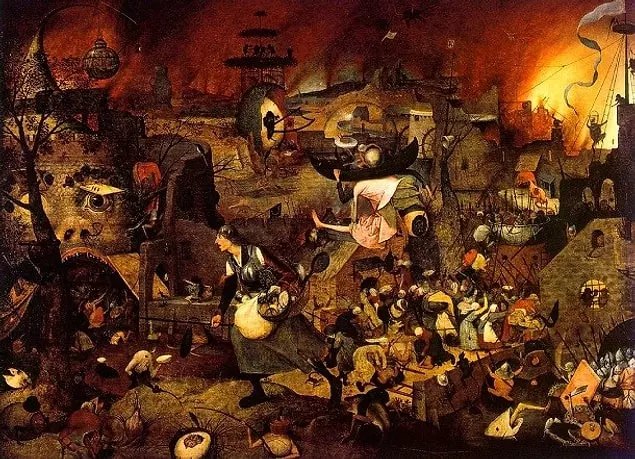
"Dulle Griet," also known as "Mad Meg," is a famous painting by Flemish artist Pieter Bruegel the Elder. The painting depicts a peasant woman, Mad Meg, who is leading an army of women on a mission to pillage the underworld.
Bruegel's use of bright colors and intricate details serves to create a sense of chaos and disorder in the painting. The figure of Mad Meg is depicted with a fierce and determined expression, while the other women in the army are depicted with a sense of urgency and desperation.
The artwork is a commentary on the complex relationships between gender, power, and social norms in medieval Europe. The figure of Mad Meg represents a challenge to the traditional gender roles of her time, while the army of women she leads suggests the potential for collective action and resistance against oppressive social norms.
#78 The Last Judgment by Fra Angelico
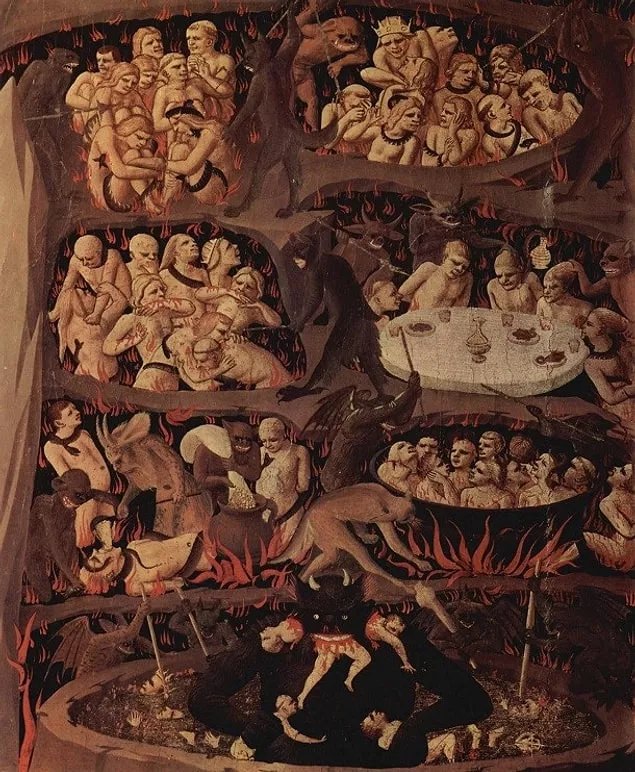
"The Last Judgment" is a famous fresco painting by Italian Renaissance artist Fra Angelico. The painting depicts the Second Coming of Christ and the final and eternal judgment by God of all humanity.
Fra Angelico's use of bright colors and intricate details serves to create a sense of awe and wonder in the painting. The figure of Christ is depicted with a sense of divine authority and power, while the souls of the dead are depicted with a sense of fear and trepidation.
The artwork is a commentary on the complex relationships between human actions, divine judgment, and eternal salvation. The painting suggests the potential for redemption and salvation, but also the consequences of sin and wrongdoing.
#79 Degas is Aged by Valério Carrubba
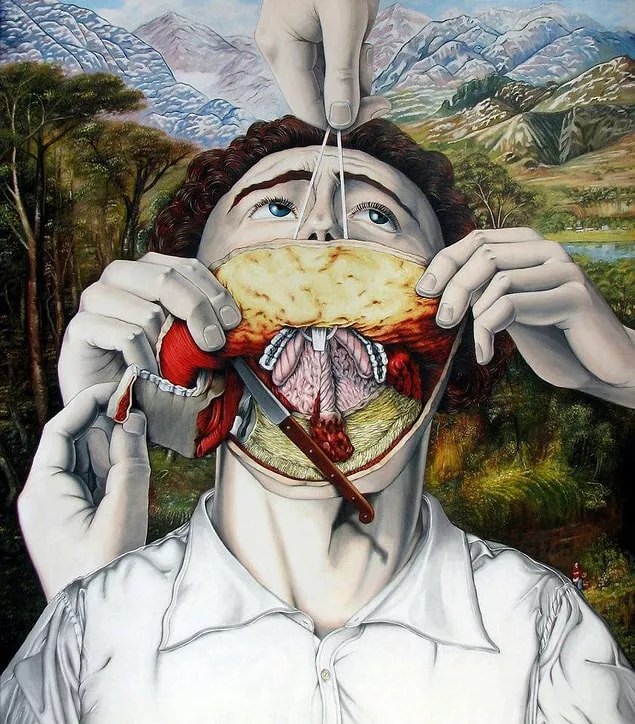
"Degàs is Aged" is a striking hyperrealist artwork created by Italian artist Valério Carrubba. The painting depicts the famous French Impressionist painter Edgar Degas in old age, with intricate details that challenge traditional depictions of human anatomy.
Carrubba's use of hyperrealism serves to create a sense of intense realism and detail in the painting. The figure of Degas is depicted with a sense of aging and fragility, with wrinkles and blemishes that suggest the passage of time.
The artwork is a commentary on the complexity and beauty of the human form, and the challenges that come with aging and mortality. Carrubba's hyperrealist style serves to capture the nuances and imperfections of the human body, and to remind us of the inherent beauty that exists in all stages of life.
#80 Night Creeper by Zdzisław Beksiński
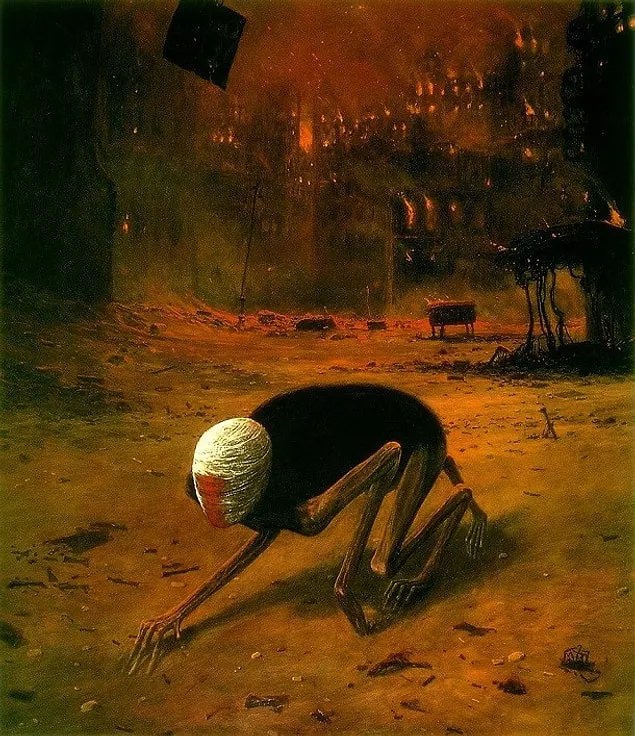
"Night Creeper" is a haunting painting by Polish artist Zdzisław Beksiński, who was known for his unique and disturbing style of "dystopian surrealism." The painting depicts a dark and foreboding figure lurking in the shadows, with intricate details that suggest a sense of danger and menace.
Beksiński's use of color and texture serves to create a sense of intense darkness and foreboding in the painting. The figure of the "Night Creeper" is depicted with a sense of malevolence and mystery, with twisted and distorted features that suggest a sense of danger and unpredictability.
The artwork is a commentary on the complexities of the human experience, and the potential for darkness and danger that exists within all of us. Beksiński's unique style serves to capture the intensity of human emotion, and to remind us of the importance of confronting our own fears and anxieties in order to better understand ourselves and the world around us.
#81 Saturn Devouring His Son by Peter Paul Rubens
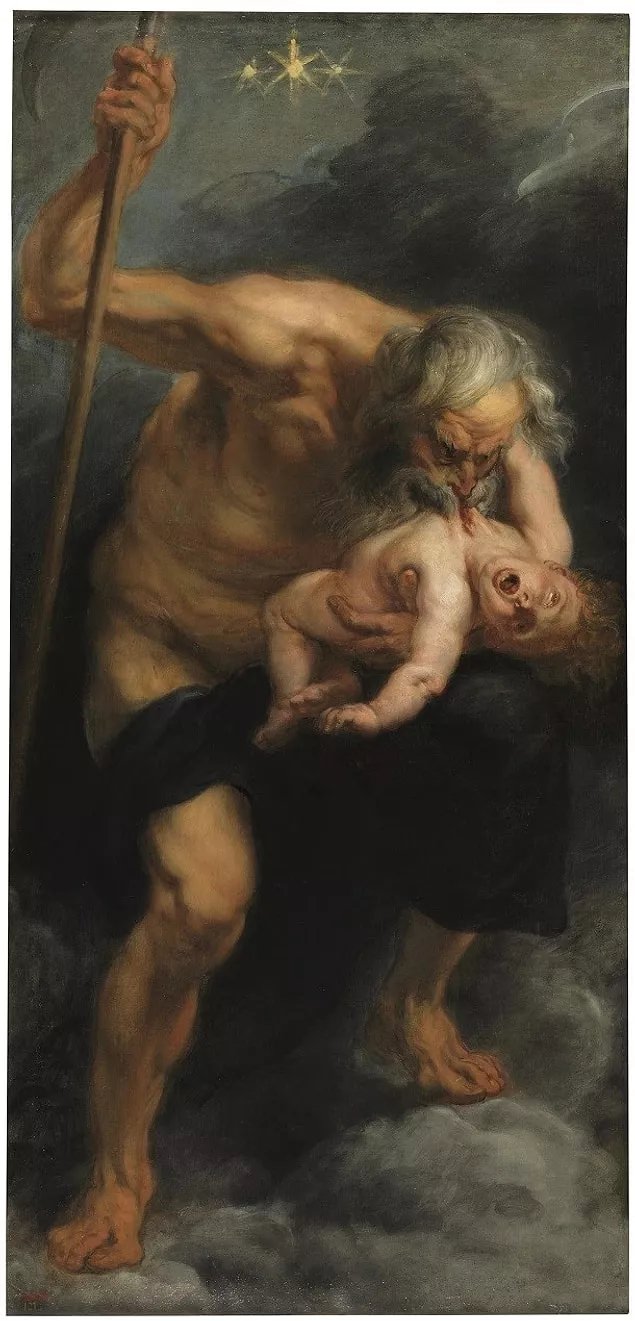
"Saturn Devouring His Son" is a disturbing painting by Flemish Baroque artist Peter Paul Rubens. The painting depicts the Greek mythological figure of Saturn, who, fearing that he would be overthrown by one of his children, ate each one upon their birth.
Rubens' use of color and texture serves to create a sense of intense darkness and foreboding in the painting. The figure of Saturn is depicted with a sense of malice and brutality, with grotesque and twisted features that suggest a sense of violence and chaos.
The artwork is a commentary on the themes of power, violence, and mortality. Rubens' unique style serves to capture the intensity of human emotion, and to remind us of the fragility of life and the potential for violence and destruction that exists within all of us.
#82 The Death of Marat by Edvard Munch
#83 The Face of War by Salvador Dalí
#84 Judith Beheading Holofernes by Caravaggio
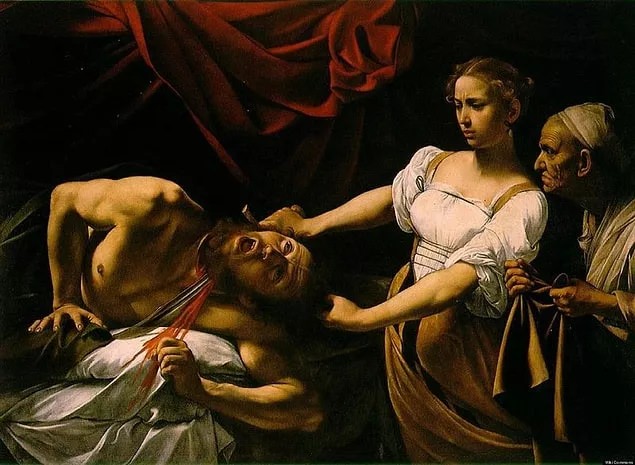
"Judith Beheading Holofernes" is one of Caravaggio's most famous and controversial paintings. Completed in 1599, the painting depicts the biblical story of Judith beheading the Assyrian general Holofernes to save her people.
Caravaggio's version of the story is particularly graphic and violent, with blood and gore splattered across the canvas. The use of chiaroscuro lighting, a technique in which light and dark are sharply contrasted, adds to the dramatic effect of the painting and creates a sense of tension and unease.
The painting is also notable for its unconventional composition, with the figures of Judith and her servant occupying the foreground and Holofernes relegated to the background. This unconventional approach was a hallmark of Caravaggio's style, which emphasized realism and emotional intensity over traditional compositional rules.



